VVAM Airborne Magazine no.12
NO.12 AIRBORNE MAGAZINE A publication by the Society Friends of The Airborne Museum 30/08/2018
TABLE OF CONTENTS
3. From the board: Society affairs
5. Obituary of honorary chairman chairman Chris van Roekel
7. Archaeology: A recently discovered shell fragment
9.Arnhem Lombok 18 / 19 September 1944
10. Learning about the Battle of Arnhem by listening
12. 1st Battalion the Border Regiment during the Battle of Arnhem
24. Ministory number 128: Determining the location of a famous photo (2)
27. Germans on the west side
28. An exciting discovery by Arnhem bridge
32. Soldiers of the Air Mobile Brigade visit the Airborne cemetary
35. 2018 Program
Cover: The tank track recently found near the bridge most likely comes from the Panzer IV depicted on the cover.
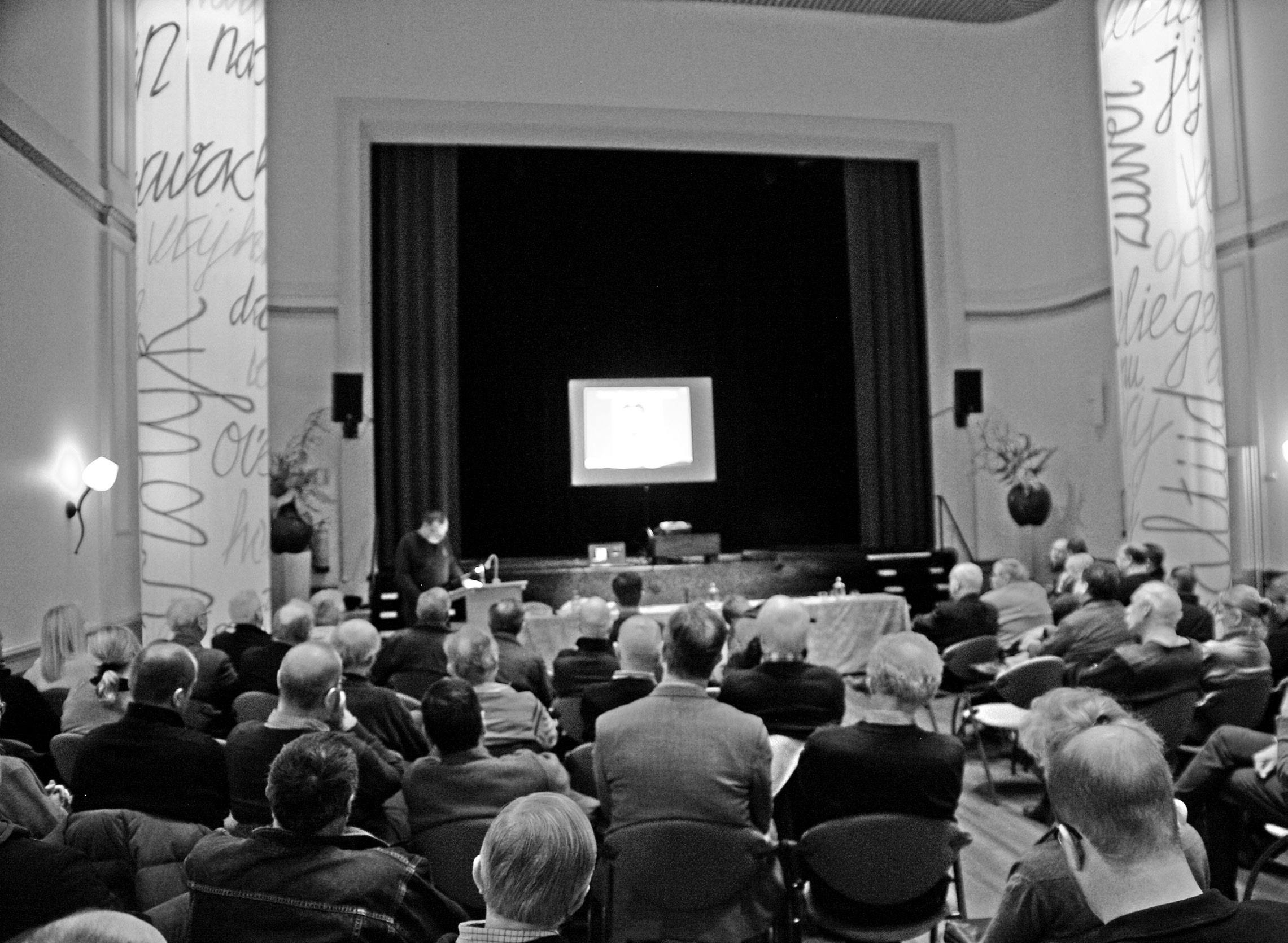
After the conclusion of the general members meetins on March 17th, retired Captain Jack Bakker, curator of the Special Forces Regiment’s historical collection, gave a lecture on the history of the unit.( Photo: Willem Kleijn)
FROM THE BOARD: SOCIETY AFFAIRS
A formal report of the General Members Meeting (GMM) of March 17 this year will appear in due course on the Society’s website, but the board feels it is important to draw your attention to some important matters at this time.
First of all, the relationship between the Society and the Airborne Museum. At the start of January we received written notification from the Airborne Museum that it had decided to cancel the existing cooperation with the SFAM. As far as the Airborne Museum was concerned there was not
enough reciprocity in our collaboration. From the point of view of the Museum, the SFAM remitted too little of its income to the museum and the Museum considered the Society was not sufficiently willing to match its activities with those of the Museum. For this reason, the Museum decided that the entrance to the Museum would no longer be free for members of the SFAM. In February, the chairman of the SFAM attempted to sit down with the chairman of the Airborne Museum Foundation. The Foundation did not respond until well after the GMM. After some postponement, a meeting has been agreed for September. The board hopes to be able to report on this meeting in the next issue.
Despite the difficult relationship with the Museum, the board is happy to see that the new direction for the SFAM is apparently appreciated.
At the time of the General Members Meeting, barely three months into the new year, the SFAM had grown by 35 members. Fifteen among them had cancelled their membership earlier.
Apart from the relationship with the Museum, the board is very concerned with regard to the
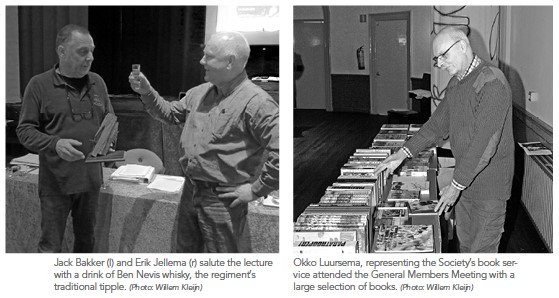 English membership. The number of English members has decreased substantially over the last few years. In part this is the result of a lack of communication due to the, necessary, inward focus of the SFAM. Moreover, the long delays between the publication of the Dutch and Eng-lish-language versions of this magazine under-standably caused considerably irritation.
English membership. The number of English members has decreased substantially over the last few years. In part this is the result of a lack of communication due to the, necessary, inward focus of the SFAM. Moreover, the long delays between the publication of the Dutch and Eng-lish-language versions of this magazine under-standably caused considerably irritation.
At the General Members Meeting several possi-ble ways of solving this situation were put forward. The board is currently investigating the possibility for a closer cooperation with the Airborne Fellowship, which has many more Eng-lish members, and has decided to carry all 2017 English members over to 2018 for free in the hope of regaining some goodwill and growth.
Moreover, the SFAM will publish all three editions of the Airborne Magazine in English as well, which will be sent to all English-speaking members. This promise was sent in the form of a letter by the chairman with the English edition of Airborne Magazine 11. However, the board is forced to conclude that producing and distrib-uting a separate English version of the Magazine is so expensive that SFAM can only afford to keep doing so if the number of English members increases substantially.
Finally, the board calls on the members of the SFAM again to consider if they are willing and able to help the Society. There is a great need of members to take responsibility in the areas of PR and communication, as well as for members will-ing to help organize the events of the Society and produce the Airborne Magazine.
CALL TO ACTION: EMAIL ADDRESSES AND YOUR PRIVACY
The SFAM tries to keep up with the times by way of, for instance, a new website and developing its Social Media presence. It is also looking to improve direct contact with its membership through, among others, digital newsletter. Therefore we would like to ask you to forward your email address via admin@vriendenairbornemuseum.nl so this information can be added to your existing data. Of course, you are free to submit a family member’s or friend’s email address if you do not have one yourself.
The new General Data Protection Act which went into force last May, affects the SFAM as well.
The board has taken action on this new law and has enacted a new, appropriate privacy statement about its membership data. The full text can be found at vriendenairbornemuseum.nl.
Very succinctly, the privacy statement contains a description of the different elements of member data controlled by the SFAM, how and why those data are collected and saved, and how members may see the data collected about them, how they may submit changes and, if they so desire, how their data may be erased from the SFAM files. For any questions, please contact the membership administrator via admin@vriendenairbornemuseum.nl
OBITUARY OF HONORARY CHAIRMAN CHRIS VAN ROEKEL
Chris van Roekel passed away at the age of 84 on June 1st. Chris was born and raised in the village of Oosterbeek, where he experienced the Battle of Arnhem. The events of the battle left a lasting impression on his life. His interest in World War Two, and in particular the battle in and around Oosterbeek, never wavered; it occupied him constantly. Hence it should hardly have been a surprise that he put all his considerable energy into the Airborne Museum and the Society of the Friends of the Airborne Museum for over forty years. He initiated countless activities for both organisastions, some of which we’ll mention here.
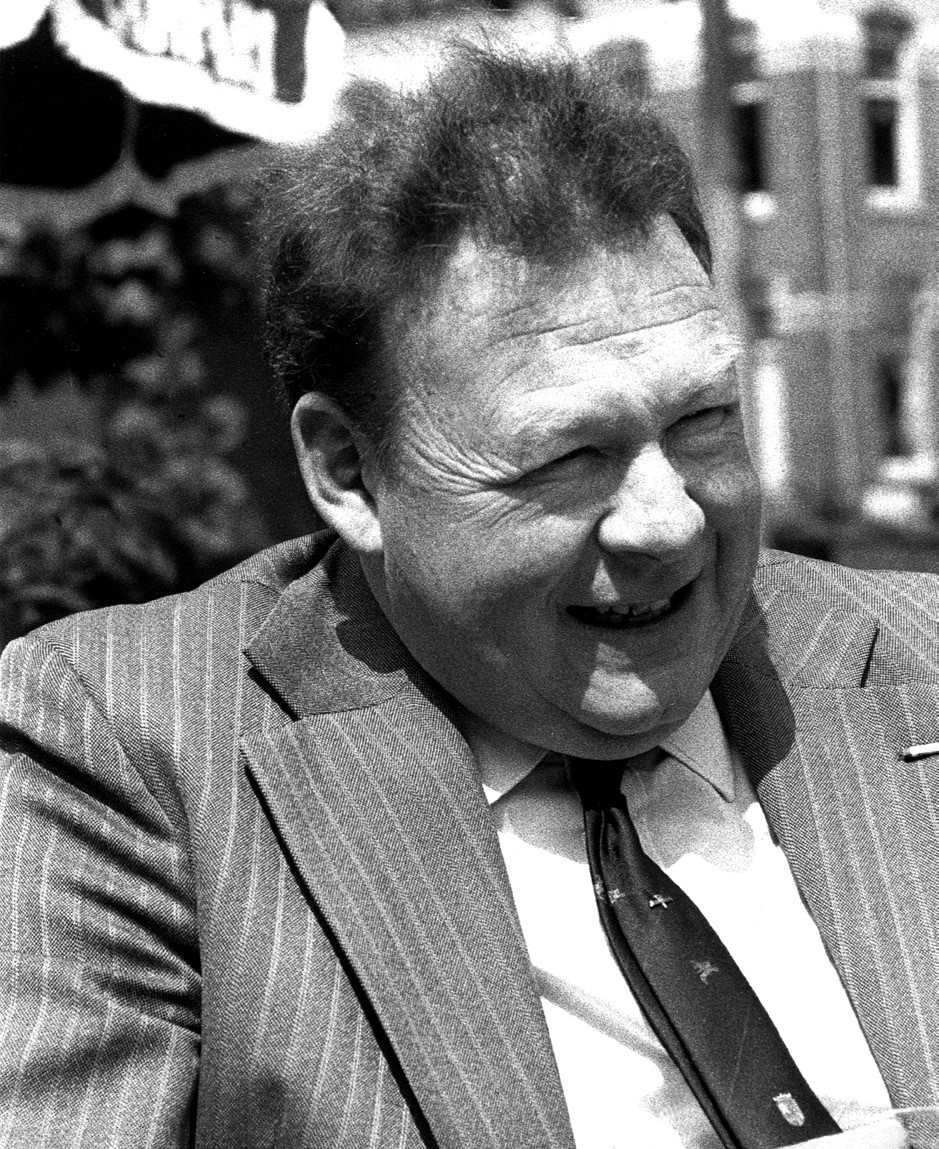
Chris van Roekel, 19342018. (Photo: Berry de Reus)
For the Society, Chris helped organize battlefield tours, among which journeys to the United Kingdom and Normandy. He lectured about the battle of Arnhem and took the initiative to start the Ministories which accompanied the SFAM Newsletter. Together with a number of volunteers he prepared, sorted and mailed the newsletter. With the secretary at the time he ran the Society’s shop and for many years he was chaired the organization as well. It made perfect sense to name him Honorary Chairman when he stepped down.
He visited the Airborne Museum nearly every day, and volunteered at the register and in the museum shop. He developed the ‘School Project’ for the benefit of the Museum, and helped develop the walking, bicycle and car routes for the area in which the battle raged in 1944. In 1993, he organized a lottery to raise money for the redevelopment of the museum. He collaborated in the restauration of the Canadian Sherman tank and the 17pounder guns around the Museum. Chris was one of the driving forces behind the purchase of the small bulldozer of the type that was transported to Arnhem by glider. His technical expertise was very welcome during the restauration of this special vehicle.
Chris was also a very active author of articles and books, among which a volume about the British Chaplains during the Battle and two books about prewar Oosterbeek. Many years he chauffeured the Leader of the Pilgrimage during the September commemorations of the Battle of Arnhem. Via a health care insurance company in Doorwerth, he was able to raise money for travel and hotel costs for disabled veterans. The Arnhem Veterans Club awarded him a silver Pegasus statuette for his efforts.
Chris was an organizer, an active worker and a fount of knowledge. He managed to achieve much, helped by his amiable character and welldeveloped sense of humour. We miss him greatly. – Wybo Boersma
MUSEUM ENTRY AND MEMBERSHIP CARDS
The board of the Society of Friends of the Airborne Museum wants to encourage its members to visit the Airborne Museum in Oosterbeek regularly, despite the fact that the original arrangement with the Museum was invalidated as of January first. The board is trying to come to a new agreement, but has not yet succeeded.
To continue to offer its members free entry to the museum, the board has decided that members will pay for their ticket at the Museum, but that they will be reimbursed by the society treasurer. A short email or letter to the treasurer with a scan, photo or copy of the entry ticket accompanied by the member’s bank data suffices. Please see the colophon for address information.
Moreover, if you own a Dutch Museum card, the board would encourage you to use it at the Airborne Museum. This benefits both the Museum and the Society of Friends of the Airborne Museum.
Taken together this means that the membership card, which has no other function within the SFAM, has been cancelled at least for 2018 to save on cost. That is why none was sent to you this year.
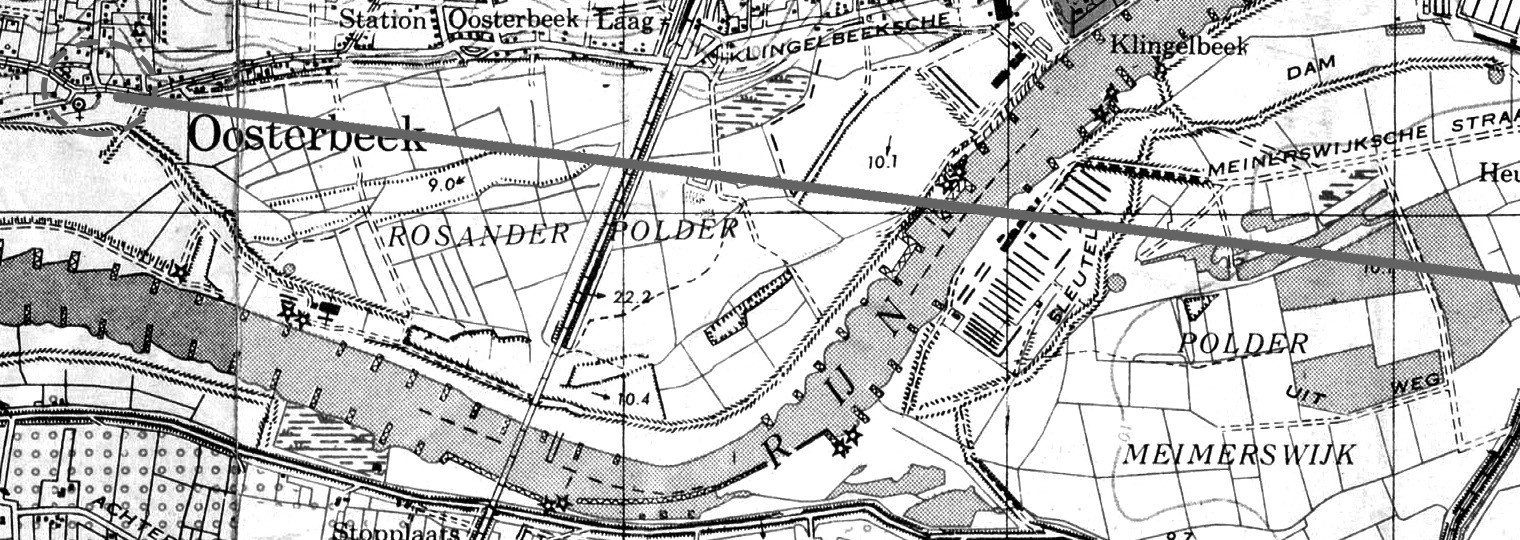
The firing line of the Pack Howitzers deployed around the Oosterbeek Old Church to Arnhem bridge( off-map).
ARCHAEOLOGY: A SHELL FRAGMENT
In 2013 and 2014 a combined archaeological and explosives examination was conducted in the southern floodplain of the Rhine across from the city of Arnhem in preparation for the Ruimte voor de Rivier (“Space for the river”) project. Both traces and finds were recorded which are connected to the building of the road bridge, a German light antiaircraft artillery position (leichte Flak), as well as the postwar Canadianbuilt Bailey bridge. It will hardly be a surprise that during this examination many fragments of ammunition were found. Any live ammunition recovered was handed over and destroyed, once all information useful for answering the research question was taken down.
Some iron shell fragments (37 in totaal), hardly significant at first sight, as well as a single brass remainder of a timed fuse were found near the abovementioned German AA position. These indications of incoming artillery fire were found immediately around the gun positions, which proves that the battery was shelled. Interestingly, Frost’s men, who were dugin north of the bridge between the evening of September 17 and the morning of September 21, received artillery support from guns deployed in Oosterbeek, a distance of some 5 kilometers as the crow flies. This fire was concentrated at targets near the southern onramp of the bridge, where the German positions were located.
This gets all even more interesting if we combine these data with the remains of some of the gun positions recovered around the Old Church in Oosterbeek in 1997 and 1998. The results of these examinations were recorded by a group of dedicated volunteers using a metal detector.
With the explicit permission of local authorities, this wellorganised group searched for missing soldiers in the Arnhem area in the 90s and 00s.
The finds recovered around the Church once belonged to the positions of F Troop, including the Troop Command Post, belonging to number 3 Battery of the 1st Airlanding Light Regiment. They were equipped with M1 75mm Pack Howitzers. From that area, to the south and east of the Oosterbeek Old Church, the group retrieved among other things several 75mm shells with their packaging materials, keys to set and modify the detonation (Setter Fuse M14), a British airbornestyle helmet, as well as a fragment of a maroonred beret with the Royal Artillery insignia still attached.
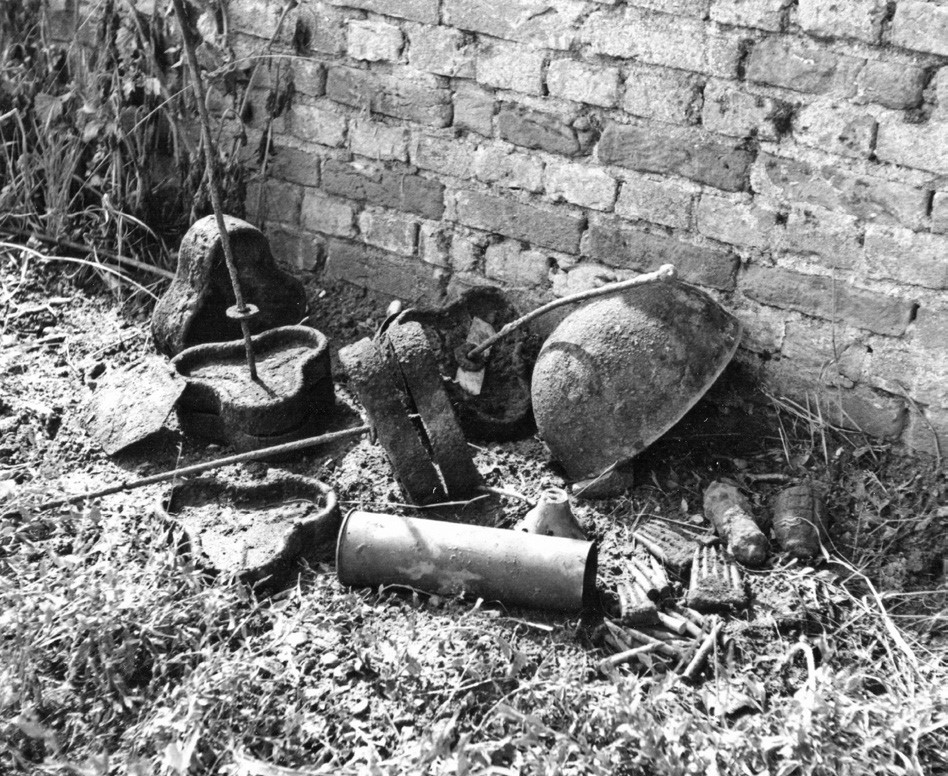
Finds from around Old Church. (Photo: Hans Timmerman)
It doesn’t often happen that both traces of the artillery positions and the results of their fire can be found and connected with any certainty. The archaeological report states that it is theoretically possible that the shell fragments belong to shells fired from the area around the Old Church in Oosterbeek, though the possibility that they were ‘normal’ 25pounder shells is not excluded. These might have been fired at the bridge area in the period betewen October 1944 and April 1945. Written sources show that the Howitzers around the Church fired in support of the British troops at the Bridge. This is thus hardly new information, but it is a kind of physical remainder of the contact that existed between the British troops within the Perimeter and those isolated around the Bridge. This way, one of the millions of shell fragments from the area can illustrate the historical narrative. – Martijn Reinders
FURTHER READING
• Bosman, A.V.A.J./R.C.A. Geerts/D. Sam (red.), 2017. Een brug te ver onderzocht. Archeologisch onderzoek in StadsblokkenMeinerswijk, gemeente Arnhem (ADC Monografie 22). • Buggenum, D. van/D. Timmerman/H. Timmerman, 1999. Weiland Nederlands Hervormde Kerk Oosterbeek. Een historisch onderzoek naar overblijfselen van de gevechten, die zich in september 1944 rondom de kerk hebben afgespeeld. • Truesdale, D./M. Cornelissen/B. Gerritsen, 2015.
Arnhem Bridge. Target MIKE ONE. An illustrated history of the 1st Airlanding Light Regiment RA 19421945. North Africa – Italy – Arnhem – Norway, Renkum.
FINDS FROM THE GROUND
In this new feature of the Airborne Magazine an archaeological find will be discussed, which is related to the Battle of Arnhem in the wider sense of the word. These may be finds from recent archaeological examinations, an accidental find, or something found in the area many decades ago. The objects under discussion here are never anonymous objects obtained at a militaria fair, or museum objects without known provenance. Nor will they only be weaponrelated matters.
Every object, however small or seemingly insignificant, has its own story to tell. They are tactile memories and sometimes personal witnesses of everyone involved in this black period of our collective history.
Martijn Reinders is an archaeologist at Greenhouse Advies, specialised in the history of the Second World War. He writes about a variety of topics related to the war, in which he combines historical and archaeological research.
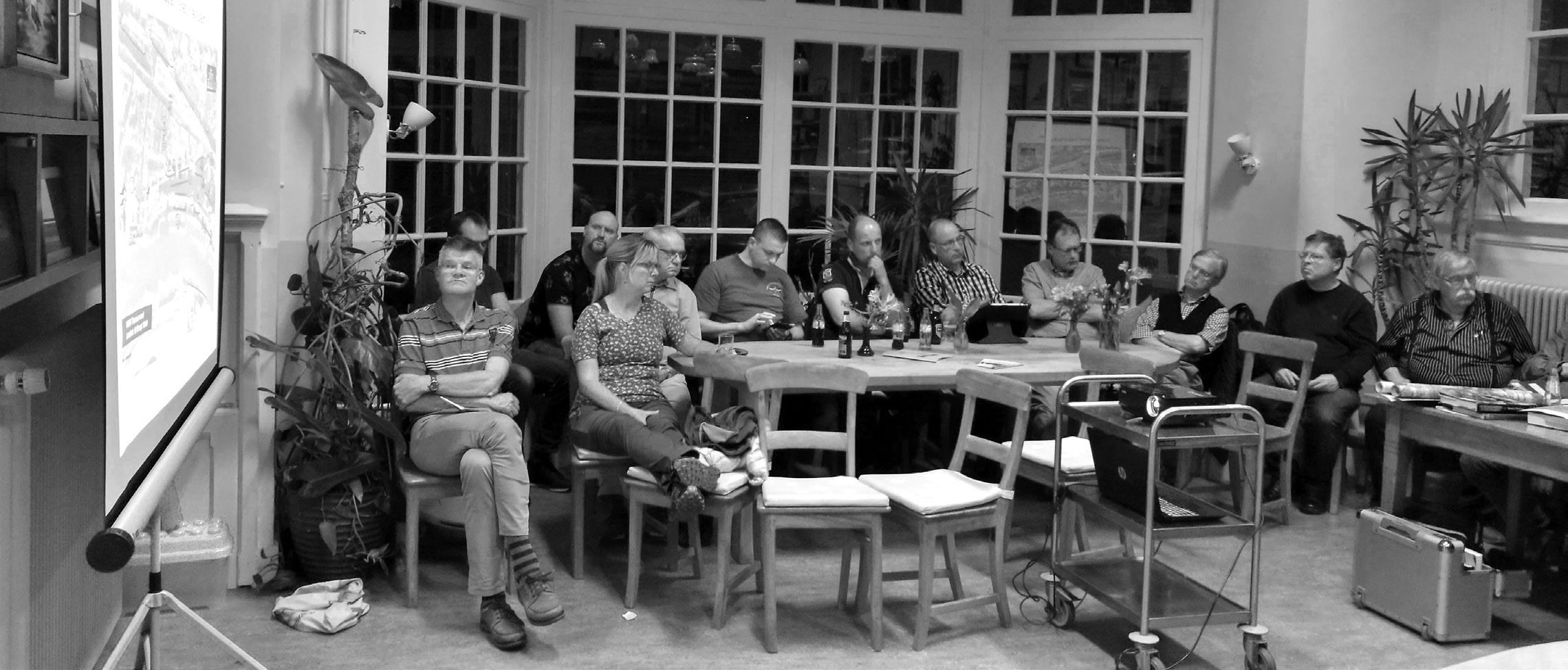
Some of the audience listening attently, somewhat later in the evening at ‘t Huukske.( Photo: Bernhard Deeterink)
NEW AIRBORNE THEME-EVENING/THE BATTLES ON THE WESTERN EDGE OF ARNHEM 18/19 SEPTEMBER 1944
On the 11th of May the SFAM conducted a successful themedevening for both members and nonmembers. The theme for this evening was the combats in the western edge of Arnhem on Monday the 18th and Tuesday the 19th of September 1944. For this event we found an appropriate location in the neighbourhood café ‘t Huuske. A cosy place adjacent to the backyard of the Zwarteweg 14. In this house MajorGeneral Roy Urquhart was forced to hide himself in the company of two other officers during the crucial phase of the operation for nearly 14 hours.
The theme for this event was chosen due to the fact that the overall picture of this decisive phase of the battle is still obscured. It’s still unclear how a substantial force of four British battalions was concentrated in this area in the evening of Monday 18th of September, just 1500 metres short of the northern side of the road bridge, without any leadership and command of the 1 Parachute Brigade.
Despite this substantial force, it could not link up with 2 Parachute Battalion of John Frost. It turned
out to be the turning point of the battle of Arnhem. By making an inventory of the insights and discussing the views of the various subject matter experts, we succeeded in creating more clarity on the course of the battle. We will present this picture during a walkthrough Battlefield Tour sometime next year combined with corresponding publications in the Airborne Magazine.
On behalf of the SFAM the evening was initiated by Erik Jellema of the Activities Commission, assisted by contributions of Dirk Hoekendijk and Gerrit Pijpers. Dirk Hoekendijk, as the owner of Battlefield tours Arnhem 1944, elaborated on the German response and their operations. Gerrit Pijpers, coauthor of Arnhem Their Final Battle. The 11th Parachute Battalion 19431944 explained 11 Parachute Battalion’s role.
SFAM’s ambition is to organise an additional themeevening on the 26th of October. The theme will then be ‘the Polish Independent Brigade’. – Otto van Wiggen
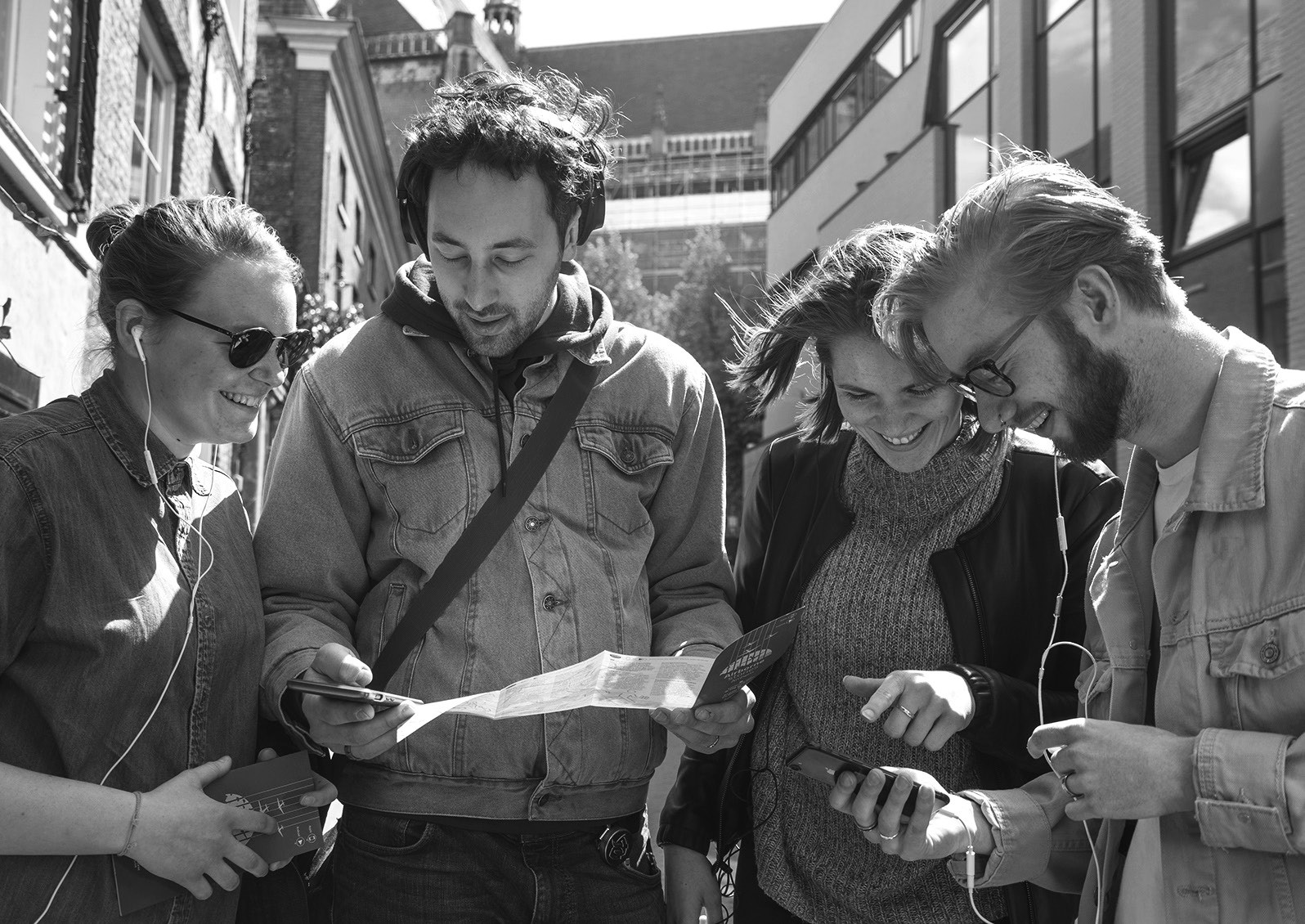
(Photo: Erik Vos)
LEARNING ABOUT THE BATTLE OF ARNHEM BY LISTENING
“When you walk this street, the Brugstraat, you will reach the railway. During the Second World War a boy called Cornelis lived in that neighbourhood. Cornelis is not afraid of anyone. One day, Cornelis witnesses a German soldier washing himself with a bucket of water. He notices that the soldier puts aside his pistol and is not paying attention to Cornelis. Cornelis grabs the pistol and runs away…..”
WHAT WOULD YOU DO?
This is one of the stories you can be informed about by listening to Airborne Stories. It’s a new listening tour about the Battle of Arnhem. The story about Cornelis continues. ‘Later that day Cornelis steals a small flag from a German military car’. It sounds like an exciting boy’s book. But then the story teller addresses you directly. ‘What is your opinion about Cornelis’s behaviour? Would you dare to do something similar? Don’t answer this question too easy with a yes. Stealing a weapon from a German soldier in these days would have you shot immediately.
Even if you were a kid’.
PROVOCATIVE QUESTIONS
Airborne Stories is based on a walking tour and an app which can be downloaded on your mobile phone. By activating the app, you will be guided along a tour that comprises 25 locations where various stories are told about what happened during the Septemberdays of 1944. The app has been developed by Erik Vos and Marko van der Vegt. They both are from Arnhem. They won a competition organised by the municipality of Arnhem. ‘We wanted to create something to connect the past with the present’ both producers explain. ‘By standing on a spot you will be thrown back in time hearing the story. Not a history lesson read out, but a lively radio play’. Every now and then the story teller will ask you questions in a provocative way. ‘What would you do? Or: how would you react if your house were on fire?’
APPLICABLE FOR EVERYONE
‘At every listening location you may choose the subject and perspective of your choice’ the writer of the stories, Richard Derks, explains. ‘You may choose the military perspective. It’s about the German and British combat operations conducted during the battle. You may also choose the perspective of the civil population of Arnhem, who suddenly found themselves entrapped on the battlefield and were forced to evacuate their home town after the battle.
And there is the opportunity to listen to youth stories. What was it like to experience the battle form a child’s perspective? I imagine walking the tour as a family. Some on is listening to one storyline, the others to a different one. Informing each other on the way what they just heard’.
Listening location nummer 18, Utrechtseweg, the military perspective: ‘Imagine. It’s twilight.
Beyond the street you suddenly observe shades of men moving along the facades of the houses. They carefully avoid making noise but the become more visible. They are British soldiers. They dislike streets like these. Too narrow and to close, without any co
verage. William Loney and Norman Shipley are at the front. Their weapons at ready. Suddenly German machine gun fire opens up on them…’
ROLLING TANKS
‘Producing Airborne Stories was a lengthy process’ Erik Vos explains. ‘Firstly, you have to do a lot of research. Luckily we were supported by historical military advice from Leo van Midden and Dirk Hoekendijk who proved themselves real experts’. Secondly, we had to translate the entire content into the English and German language. After we did so, the voice actors could get to work. Claire King, Erik van Schaaik and many others taped the 75 stories.
Finally, Rien Valk was able to produce the sound editing. The singing of the birds, the sound of footsteps, the buzz of various people speaking to each other….But the sound of gunfire, rolling tanks and aircraft flying overhead as well. After that, developing and making the app needed to be done. All in all the project took us more than a year’.
Listening location 25, Boterdijk, civilian perspective:‘Take a look at your feet. You are literally standing on the remans of the city. After the liberation in May 1945, the inner city of Arnhem was turned into a mess. More than 3000 houses were completely destroyed. After the war, district by district needed to be cleaned and rebuilt.
The centre of Arnhem came last. Usable material was stored here at the northern side of the Rhine river and to be used for the reconstruction. The remaining debris was used to fill up the Old Harbour. That harbour once was here….right were you are standing’
HIKING MAP
The route is easy to be followed using the app, or a small hiking map that is for free. But you can also follow the red sidewalk tiles. The listening locations are indicated by metal ‘pushpins’ in the sidewalk.
The app is accessible in three languages. The hiking map is for free. The project Airborne Stories has been accommodated by the municipality of Arnhem.
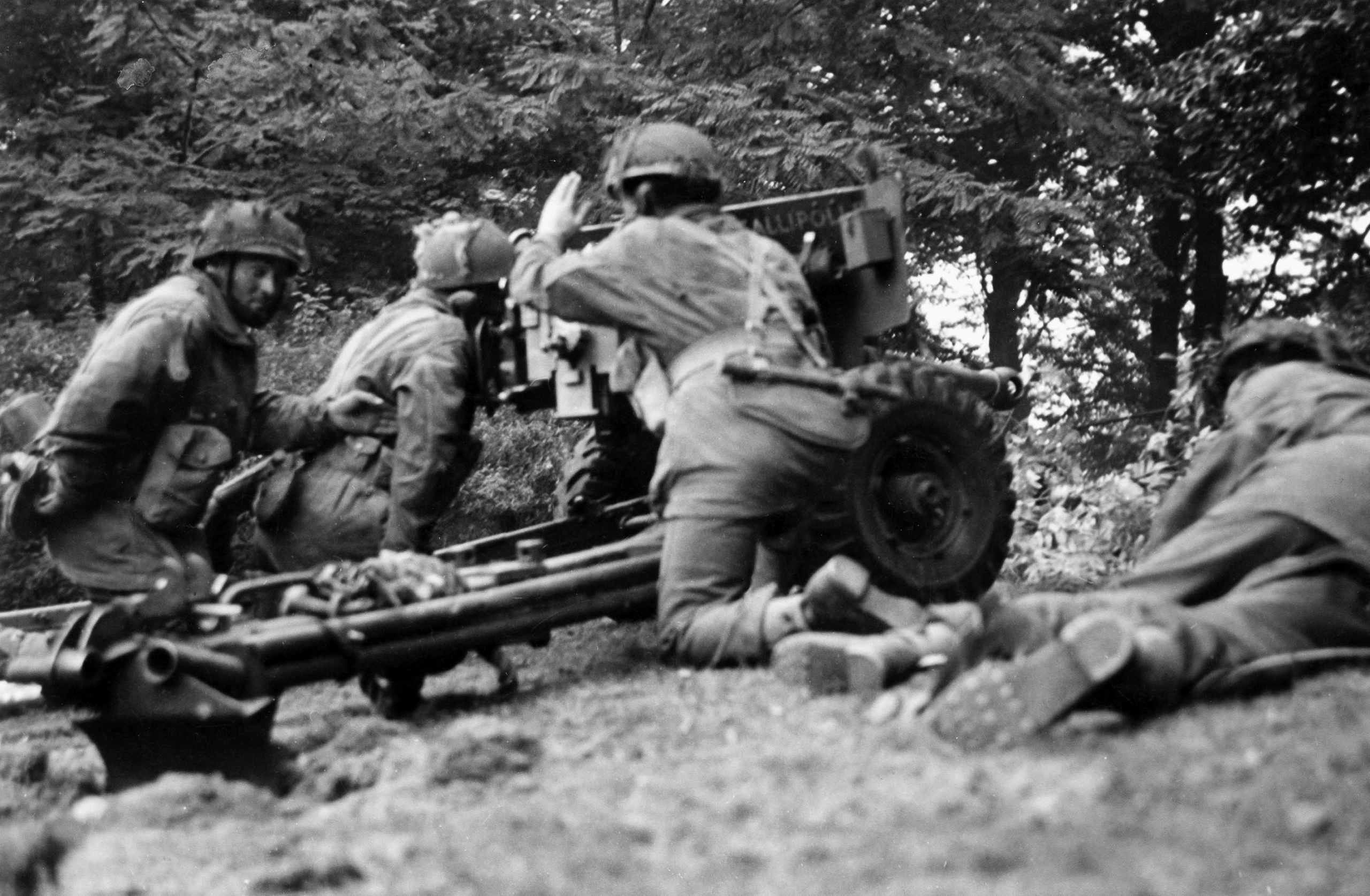
Antitank gun Gallipoli 2 taking out a Char B at Koude Herberg.( Photo: credit this)
1ST BATTALION THE BORDER REGIMENT DURING THE BATTLE OF ARNHEM
On Saturday the 6th of October the Society of Friends of the Airborne Museum (SFAM) will conduct the Battlefield tour 1st Border Regiment during the Battle of Arnhem. Erik Jellema and Mr. Luuk Buist will act as your guides. This article is to provide background information and is mainly based on the book ‘When Dragons Flew’.
1 Border was part of 1st Airlanding Brigade. After landing on September 17th 1944 in gliders on Landing Zone (LZ) S, its task was to secure LZ X for the first and second lifts. After accomplishing these tasks the battalion was to withdraw to phase 2 positions in the divisional airhead. 1 Border exactly executed its mission according to the plan. In the end the battalion was responsible for the defence of the western perimeter.
In England the battalion was stationed around Woodhall Spa, in Lincolnshire, about 120 kilometres north of London. September 17th. 1 Border flew in 56 Horsa gliders from the airfields Broadwell and Blakehill Farm and in Hamilcar gliders from Tarrant Rushton. September 18th another 6 gliders flew from Down Ampney. 1 Border left England with 788 men; during the battle 121 were killed in action, 235 escaped crossing the Rhine and 432 men became POW, some of them wounded. This operation turned out to be the most difficult for the battalion during WW2.
The Border Regiment had seen heavy battles in the past. The oldest inscription in the Border cap badge is “1811 Arroyo dos Molinos”. The Battle at Arroya was part of Wellington’s campaign against Napoleon in Spain. The regiment was a British Regiment formed in 1881 by amalgamation of the 34th (Cumberland) Regiment of Foot and the 55th (Westmoreland) Regiment of Foot. The district of the regiment consisted of the counties Cumberland and Westmoreland and the depot was, and still is, Carlisle Castle.
During WW1 the regiment fought amongst other places at Gallipoli 191516, Cambrai 1917, Arras 191718 and on the Somme 19161918. 1st Battalion The Border Regiment in 19391940 was part of the British Expeditionary Force (BEF).
After Dunkirk the battalion trained for mountain warfare, but in October 1941 transformed into an air landing battalion of 1st Airborne Division. In July 1943 it saw action on Sicily. During this operation the battalion suffered heavy casualties. Out of 796 officers and men only 200 returned from this campaign. Many were drowned at sea due to gliders prematurely landing on the Mediterranean Sea after being shot down at by allied ships.
FINAL DAYS IN ENGLAND
Due to the losses of the Sicily campaign the battalion was transferred back to England in December 1943. The battalion was stationed in and around Woodhall Spa in Lincolnshire. Nowadays every year in July there is the Woodhall Spa WW2 Festival. During a whole week the town is dressed up as if it was WW2.
After Sicily Major Haddon as 2nd in Command took command of the Battalion. Visits followed by Major General Urquhart, Field Marshall
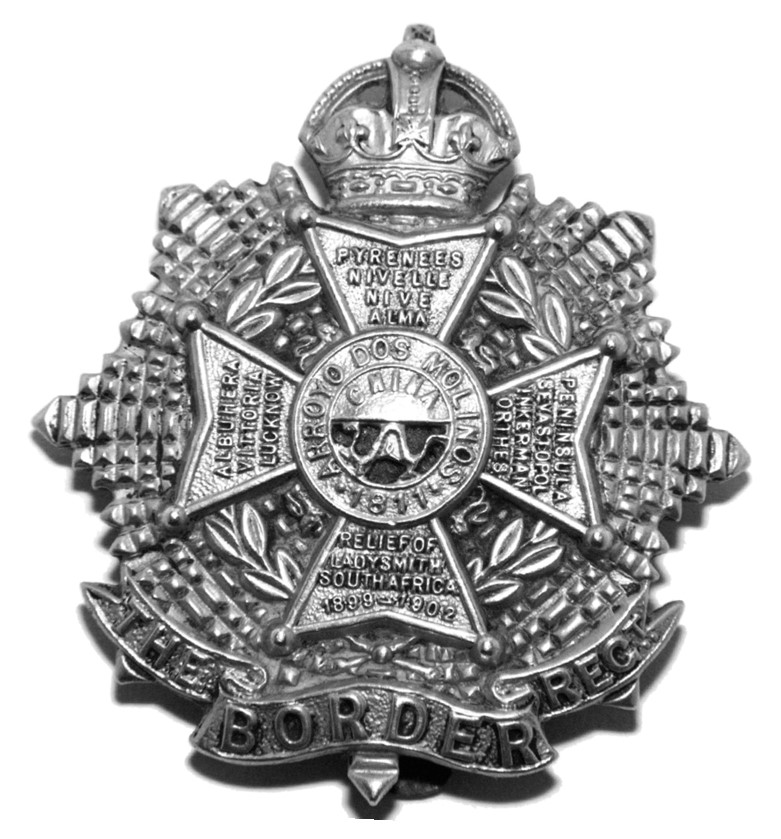
Border Regiment cap badge.
Montgomery and the King at Woodhall Spa. During that time Canadian officers were welcomed in the battalion under the so called Canloan Scheme. In 1944 the battalion took part in big airborne exercises. After DDay the battalion was alarmed many times for operations that were cancelled at the last moment.
One of the operations, Operation COMET, planned for September 10th, changed into operation MARKET, in which most of the 1st Allied Airborne Army, including two US Airborne Divisions, was involved. At 1700 hours on the 12th of September Major General Urquhart conducted his Orders Group for his brigadiers. This took place at Moor Park, the HQ of 1st (Br) Airborne Corps. Urquhart had his caravan located here. In this caravan Urquhart planned the Concept of Operations of 1st Airborne Division within the given restrictions. As part of this plan 1st Airlanding Brigade was to secure the landings of the 1st and 2nd Lifts. After the 2nd Lift on Monday the 18th 1 Border was to occupy defensive positions in the divisional airhead.
1 BORDER’S MISSION WAS:
Phase 1:
• Establish a strong company group at Renkum 6276;
• Protect DZ X and LZ Z until Divisional Troops are clear.
Phase 2:
• Move on orders the Brigade Headquarters to occupy area Koude Herberg 6873;
• Establish a post in Heveadorp area;
• Block the route between RenkumArnhem
• Dominate area between Koude Herberg and Westerbouwing (with special reference to ferries).
The Operational Orders for Operation Market show how Support Coy placed its MMG, antitank, and mortar platoons under command of the infantry companies. Moreover, it stands out that BCoy had to seize and hold ferries in Phase 1 at Renkum and at Westerbouwing in Phase 2, but the intention of seizing the ferries is not made explicit.
After September 5th the battalion was stationed around Burford near the Broadwell airfield. On september 17th, after a good breakfast, the battalion left for the airfields Broadwell and Blakehill Farm. The trucks delivered the units next to the de gliders directed by the chalk numbers. 44 Horsas flown by pilots of 16 Flight, F Squadron The Glider Pilot Regiment (GPR) augmented by pilots of 2 Wing HQ and a section of 10 Flight, G Squadron, left from RAF Broadwell.
C Coy and jeeps of the mortar platoon left with 12 Horsas from RAF Blakehill Farm flown by pilots of 14 Flight, F Squadron GPR. The two Bren carriers left in a Hamilcar flown by pilots of C Squadron GPR from RAF Tarrant Rushton. Nowadays, the former RAF Broadwell is largely a solar power park. RAF Tarrant Rushton was besides base for the heavy Hamilcars an airfield for SOE (Special Operations Executive).
This airfield was also used for the Coup de Main at Pegasus Bridge on DDay.
The first glider left at 0945 hours. Five gliders crashlanded in England. The 6 pounder
antitank gun with the name ‘Suvla Bay’ had to stay behind. ‘Suvla Bay’ was an invasion beach in the Gallipolicampaign of 1915. The glider with the Commanding Officer, Lieutenant Colonel Haddon, did not leave England either. 13 platoon of B Coy, commanded by Canadian Lieutenant Wellbelove, struck the same fate. 19 platoon of D Coy and the Transport platoon with the reserve ammunition were earmarked to fly with the 2nd Lift in 6 Horsas from Down Ampney, flown by pilots of E Squadron, GPR.
GLIDER LANDINGS AND PHASE 1 POSITIONS
Landing Zone S was marked by 3rd platoon Pathfinders. At 1300 hours the glider landings started. 134 of the planned 153 gliders arrived safely at LZ S (source: Martin Middlebrook). For the glider landings 40 minutes were reserved. After the gliders the paratroopers were to jump. The southwest part of LZ S was earmarked for 1 Border. The battalion rendezvous was the southwestern forest point just north of the railroad. Martin Middlebrook (page 100) is convinced that the glider flown by Lieutenant Colonel John Place, with on board Private Johnny Peters of 14 platoon B Coy 1 Border, was the first glider to land. Near the farm Reijerscamp and hotel Buunderkamp several German soldiers were made prisoner.
Some Germans had fired at the gliders. Private Stripp of 20 platoon of Lieutenant Alan Green was wounded in the arm. The landings were a success, there were only a few casualties. But some gliders crashlanded in England, on the North Sea or over the Netherlands. These losses were felt. Within the arrived platoons the losses were light. 1 Border suffered two killed by German fire. But if a glider did not arrive a complete platoon was missing a simple consequence of using gliders.
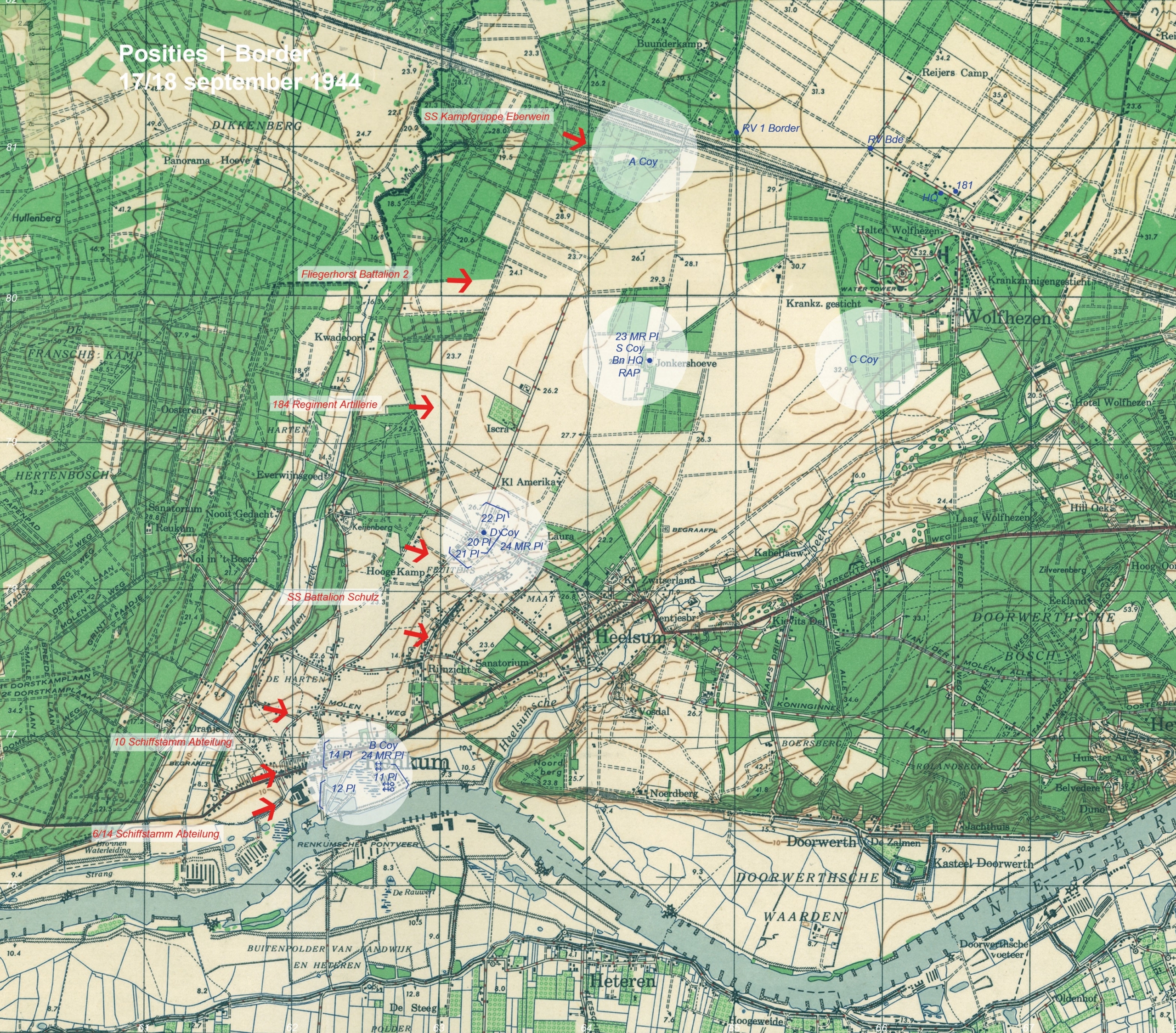
Positions 1 Border 17/18 September 1944
Retrieving some antitank guns turned out to be problematic. But in the end, seven out of eight 6pounders were retrieved. The gun ‘named ‘Suvla Bay had remained in England.
Gun ‘Gallipoli II’ was attached to A Coy of Major Montgomery. Guns ‘Ypres’ and ‘Somme’ were attached to B Coy of Major Tom Armstrong. The guns ‘Hellespont’ and ‘Scimitar Hill’ went to C Coy of Major Jock Neill. ‘Cambrai’ and ‘Arras’ were found at D Coy of Major Charles Breese. An air landing battalion, like 1 Border, had its own antitank platoon consisting of eight 6pounder guns. Contrary, a parachute battalion did have an antitank platoon commander, but its guns were attached from 1st Airlanding AntiTank Battery Royal Artillery. This 1st Airlanding AntiTank Battery detached its A, B and C Troop to 1st, 2nd and 3rd Battalion The Parachute Regiment. D Troop with 17pounders was detached to the Division and Z Troop with three 6pounders was tasked to defend the Division Headquarters. P Troop with 1 pounders was attached to the Light Regiment RA.
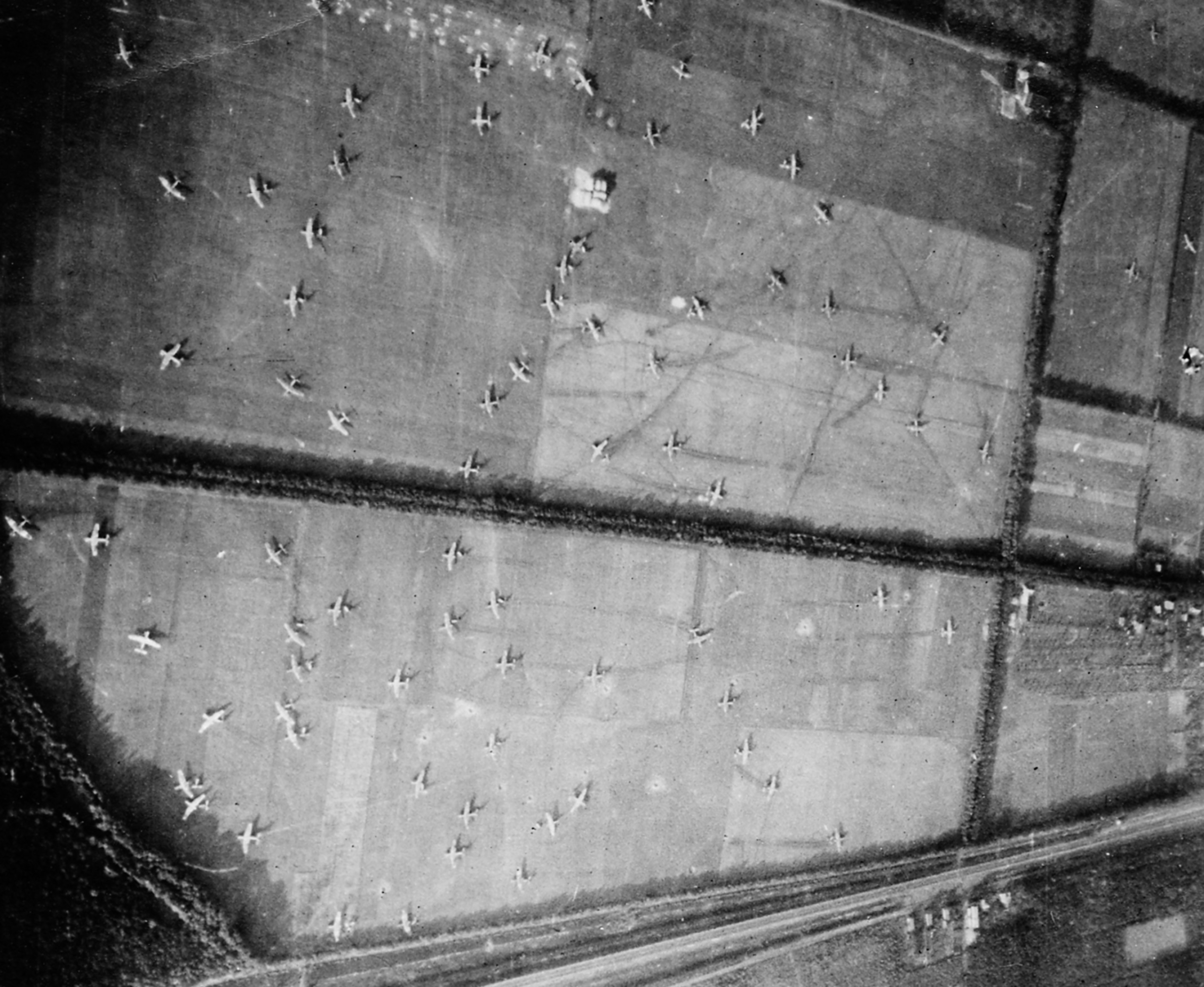
Landing Zone S. 1 BORDER landed in SW corner; RV in SW forest point.
After the drop of 1st Parachute Brigade, 1 Border moved to its Phase 1 positions (see Map 1). The Battalion HQ and Regimental Aid Post (RAP) moved into the farm Jonkershoeve. A Coy dug in at the North west corner of DZ X. B Coy had a long way to go in order to arrive at the ferry at Renkum. This Coy followed the Telefoonweg (road) over Heelsum to Renkum. C Coy crossed the LZ Z and dug in just SW of Wolfheze. In the same area was the Division Headquarters until it came under bombardment from Nebelwerfer (rockets). Then the Division Headquarters moved into 6 Horsas on the landingzone. D Coy secured the crossroad Telefoonweg in Heelsum.
Mortar support for A and C Coy was provided by 23 Mortar Platoon. 24 Mortar Platoon accompanied B Coy to Renkum. Also accompanying B Coy were two Vickers Medium Machine Gun sections and two antitank guns (‘Ypres’ and ‘Somme’). On the road to Renkum B Coy had its first (4) German Prisoners of War (POW) and found two German machine guns MG34. In Renkum B Coy had its first firefight. A German lorry was fired at. After this engagment more POWs were taken. At the Renkumse ferry more Germans were located.
On arrival at Renkum 12 platoon took position between the ferry and the road Wageningen-Arnhem, with its front West and Northwest. 14 platoon dug in North of that road, front West. 11 Platoon moved into a brick factory, front East. 13 Platoon, as mentioned, did not arrive on the first day. At Renkum the problems with signals started for B Coy. At night more and more German soldiers moved into the brick factory. During the night a flare was fired and some Germans were shot.
D Coy in Heelsum had a firefight with Germans arriving in a lorry.
At Battalion HQ it became clear that the Commanding Officer, Lieutenant Colonel Haddon did not arrive. A change in command took place. The deputy commander, Major Cousens, became acting battalion commander.
THE OTHER SIDE OF THE HILL
On the other side of the hill, opposite 1 Border, was Kampfgruppe von Tettau. This ad hoc unit consisted of several German units who happened to be in the area. There was Fliegerhorst Bataillon 2, a Luftwaffe unit from airfield Soesterberg, SSBataillon Schulz, SSStandartenführer (colonel) Lippert’s Unteroffiziersschule (NCO school) Arnheim and Schiffsstamm Abteilung 10 of the German Navy. Later the SS Wachbataillon 3 arrived, Dutch SS under command of Hauptmann (captain) Helle. Further in reserve the 184 Artillerie Regiment acting as infantry. This year, at the end of September 2018, a new book from Bob Gerritsen will be published, describing the actions of SSUnterführerschule Arnheim (see also p.27).
MONDAY SEPTEMBER 18TH
At 0700 hours in the morning B Coy at Renkum discovered a large German group at about 200 metres in front of their position. This Schiffsstamm Abteilung 10 (German Navy) was tasked to ad
vance east. The Germans were not aware of B Coy in the brick factory and were assembling around a motorcycle. 10 Lee Enfields and two Brenguns opened fire. After this initial success the Germans recovered. With new reinforcements arriving, they started to mortar the British position. At 1400 hours B Coy was ordered to withdraw in the direction of Heelsum. This turned out to be impossible. B Coy was almost surrounded. The only way out was following a track along the Rhine dyke in the direction of Doorwerth castle. 11 Platoon acted as rearguard. The Germans attacked at 1500 hours, but B Coy already left its previous defensive positions. The withdrawal was a success, but some vehicles, two antitank guns and the mortars were left behind. The Vickers MMG’s and the ammunition were carried by hand.
D Coy in Heelsum was attacked by SS Bataillon Schulz that advanced to contact. Fliegerhorst Bataillon 2 (Soesterberg) advanced north of Heelsum and got in contact with 20 platoon on DZ X. In this fight Sergeant Sears and Private Walker were killed. 21 Platoon of Lieutenant Holt was fighting off infiltrating Germans. Even in the forest “Laura” just east of D Coy some Germans were seen.
British artillery was tasked on this forest. Antitank gun ‘Cambrai’ accompanying D Coy was hunting a captured French Char B tank of Panzerkompanie 224. This German training unit drove all the way from the Dutch coast!
At 1100 hours 30 ME 109 Messerschmidts (Fighter Aircraft) machine gunned the Drop and Landing Zones. This resulted in 7 killed and 14 wounded in A Coy. The coy initially thought these aircraft to be British Typhoons.
The 2nd Lift was delayed and arrived at 1500 hours. They were 4 hours late. The Germans fired at the landing gliders at LZ X. The Border gliders that crashlanded on September 17th in England arrived with the this Lift, but (again) not the one with Lieutenant Colonel Haddon. His glider was shot over Herentals in Belgium and had to land on the Albert Canal.
They were able to contact troops of 30 Corps.
The missing platoons 13 of B Coy and 19 of D Coy and 17 of C Coy arrived safely and were able to report to their units.
PHASE 2 POSITIONS
At 1900 hours, after the successful execution of the 2nd lift, the sub units of 1 Border moved towards their phase 2 positions. A Coy moved cross country over LZ Z to the forest edge near Wolfheze. On this open terrain A Coy was fired at. This firefight caused an enormous delay. It took 5½ hours for most companies to arrive at their designated positions. A Coy dug in positions between Graftombe and castle ‘De Sonnenberg’, northeast of the crossroad Koude Herberg. Platoons 17 and 18 were near the crossroad, platoons 15 and 16 a bit more east of them along the “Van Lennepweg”. Here the antitank guns ‘Hellespont’ and ‘Scimitar Hill’ took position. Only pictures of ‘Gallipoli II’at the Van Lennepweg are known. That is a bit strange because ‘Gallipoli II’ was attached to A Coy. B Coy arrived at Westerbouwing. Probably via the road RenkumDoorwerthWesterbouwing, but maybe some sections MMG passed through Heelsum and the positions of C Coy and following the “Van Borsselenweg”.
B Coy, now without antitank guns and mortars, was left behind in Renkum. D Coy spent the night near a feature Hoog Oorsprong before it took positions on Van Borsselenweg, halfway between Koude Herberg and the Westerbouwing. 19 Platoon D Coy established a separate position a kilometre west of D Coy HQ. Battalion HQ moved into a house at the Van Lennepweg 3. Just north of this location (in villa Geldershof ) the Regimental Aid Post moved in. Just south of Battalion HQ the mortars of 23 platoon were dug in. Iconic footage and pictures were taken of one of the mortar positions of this platoon. 1 Border, in the end, was defending a frontage of 2500 metres as the crow flies in woodland terrain. The positions could not cover this entire area. This offered the Germans opportunities to infiltrate wherever they wanted. Map 2 with phase 2 positions depicts the platoon positions.
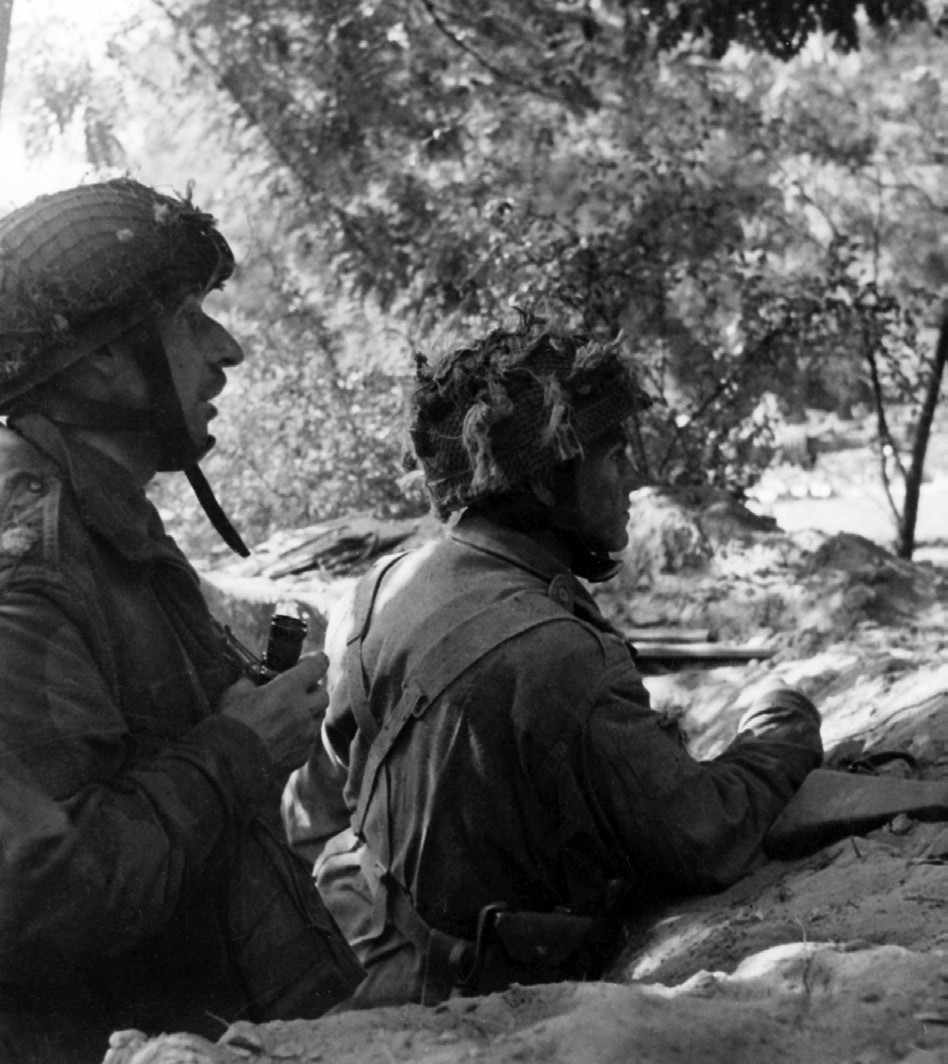
Major Neill, OC C Coy and Lt McCartney in their position at van Lennepweg.
TUESDAY SEPTEMBER 19TH
In the morning reports came in that German troops were attacking along the entire defensive position of 1st Border. C Coy suffered several wounded due to mortaring. At 1500 hours A Coy was machine gunned (again) by 12 ME 109 fighter bombers. This coincided with the arrival of the 3rd Lift at Johannahoeve. One hour later at 1600 hours the first resupply took place. On this day Flight Lieutenant David Lord, VC was shot down. Around 1900 hours firefights started with troops of Kampfgruppe von Tettau that advanced towards Oosterbeek.

Phase 2 positions of 1 Border.
WEDNESDAY SEPTEMBER 20TH
On the same day 82nd Airborne Division supported by tanks of the Grenadier Guards seized the bridge at Nijmegen, there was heavy fighting in Oosterbeek. At 0600 hours all units of 1 Border were shelled and mortared. The crew of the gun ‘Hellespont’ in C Coy position was hit. Attacks from Kampfgruppe von Tettau were supported by tanks of Panzerkompanie 224. A and C Coy were attacked by SS Bataillon Eberwein en Fliegerhorst Bataillon 2 coming from Wolfheze. D, and B Coy were attacked by SSBataillon Schulz, Schiffsstamm Abteilung 10, and Bataillon Wossowski of the Hermann Goering Ersatz und Ausbildungs Regiment. These attacks were supported by Nebelwerfer. At 1000 hours the first serious attack was launched against A Coy. 10 Platoon reacted with a burst from a Brengun that killed the German tank commander. Moments later, C Coy was attacked. That attack was also supported by tanks. From this day it became almost impossible for D Coy to transport the wounded to the RAP. 19 Platoon still in the westerly outpost position North of Heveadorp on the Oosterbeekseweg could fight off an attack by an armoured vehicle using a PIAT. The platoon commander of 19 platoon had no communication with D Coy and decided after he repulsed this attack to fall back to the defensive positions pf D Coy. During this withdrawal the platoon ran into various German patrols which caused the platoon to fall apart. It took the platoon commander two days to reach the positions of D Coy.
Iconic picture of 23 Mortar platoon.
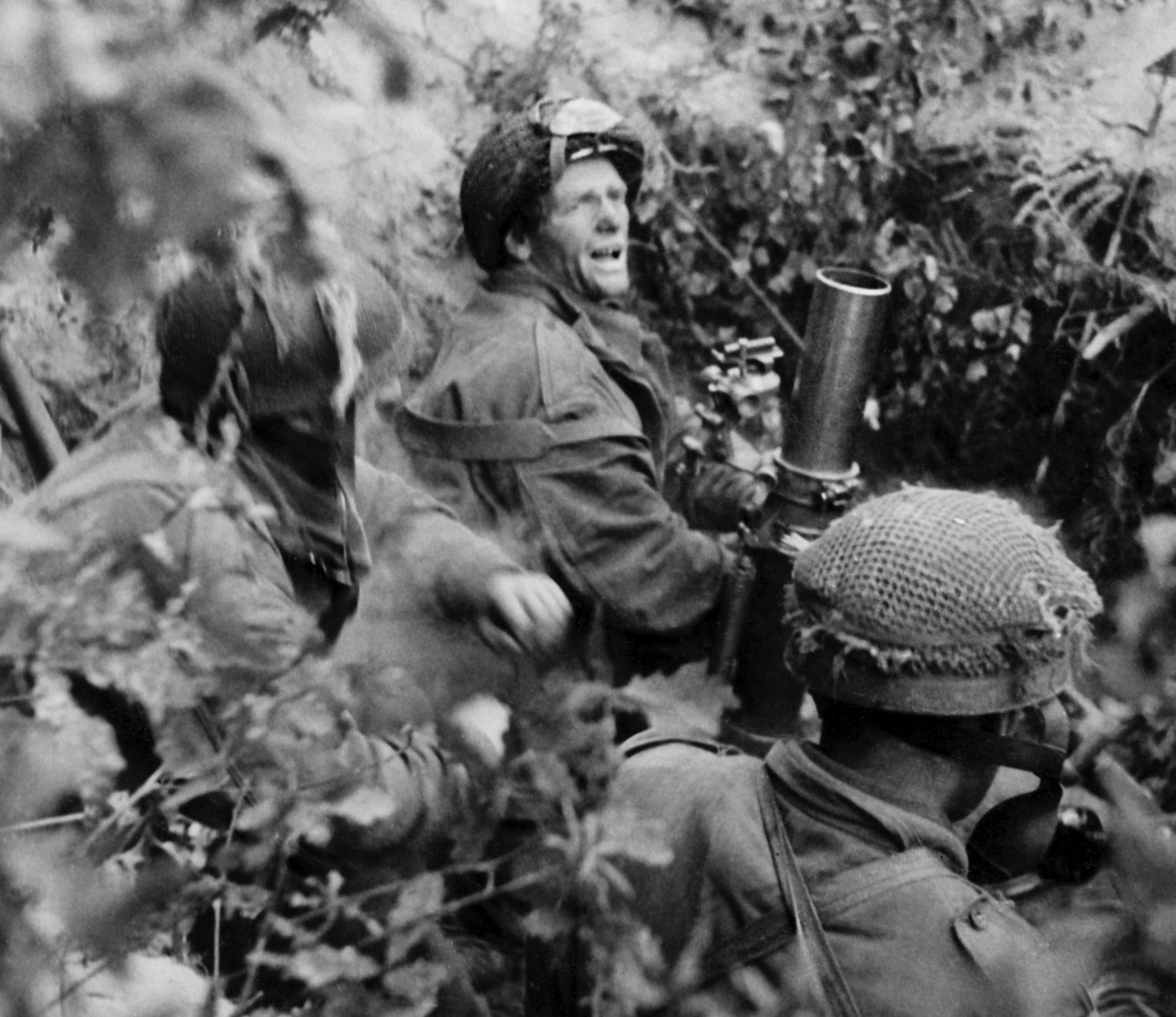
Iconic picture of 23 Mortar platoon.
B Coy also was attacked. The sound of tracked vehicles was heard. Some Germans on their bicycles even rode into the position undetected.
At 1500 hours C Coy was attacked. The attack at Koude Herberg was supported by two flamethrower tanks of Panzerkompanie 224 and a third armoured vehicle. Sergeant Walker of the Army Film Unit filmed how antitank gun ‘Gallipoli II’ (van Lennepweg) disabled a German tank at a distance of 90 yards. Another Char B flamethrower tank was destroyed by one of C Coy antitank guns. At the end of the day a further resupply took place.
THURSDAY SEPTEMBER 21TH
The day started with German shelling and mortaring causing many wounded. Field cables were also destroyed which resulted in chaos.
Von Tettau had reorganised his Kampfgruppe and ordered infantry to secure the tanks of Panzerkompanie 224. On this day the German main effort was directed against B Coy. As of 0900 hours the Bataillon Wossowski, supported by 4 Char B tanks, attacked. B Coy had left its 6pounder antitank guns behind on Monday already. In order to support B Coy, the battalion had sent two new mortars, but could not afford
sending additional antitanks guns. B Coy however succeeded in destroying 3 out of 4 Char B’s with PIATs. Apparently a dead cow was used as cover for the PIAT. The fourth tank disengaged.
The Wossowski battalion (600 men) however outnumbered B Coy and were able pushed the British of the Westerbouwing. The Germans suffered many casualties caused by British artillery fire. During a counter attack of 13 platoon Canadian Lieutenant Wellbelove was killed.
Sergeant Watson, who commanded 14 platoon, also was killed that day.
After the loss of the Westerbouwing Major Tom Armstrong with 50 men conducted a counter attack. This attack failed and Major Armstrong was wounded and became a POW. After this, B Coy was no longer an effective fighting unit.
Lieutenant Royal located his 12 platoon at a gas factory a bit more east. Remnants of 11 platoon of Lieutenant Barnes fell back on villa Dennenoord. This platoon was able to link up with the ad hoc unit Breese Force that was located between D Coy and the remnants of B Coy. A second counter attack to regain the Westerbouwing was initiated but it failed before it started.
After the seizure of the Westerbouwing the Germans turned their attention towards D Coy. When they attacked the defensive positions of D Coy Lieutenant Holt of 21 platoon was killed by mortars. This German attack was again supported by tanks. From the west using the forest track, two tanks advanced to the D Coy positions. The first tank fired, which killed Lieutenant Brown, platoon commander of 22 platoon, and at that moment acting deputy company commander. The tank drove into the D Coy position. A 6pounder antitank gun was pointed in the wrong direction. The tank fired an created more havoc. A second antitank gun (Arras) was brought into position. Arras fired 6 shells into the German tank from a very short distance. Lieutenant Alan Green of 20 platoon tried to attack the second tank with a PIAT. The stiff opposition of D Coy using antitank guns, PIATs and artillery made the Germans abort their efforts. All officers of D Coy, except Captain Hodgeson, were killed or wounded.
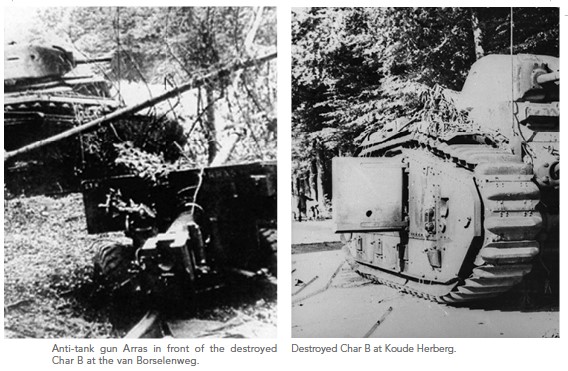
C Coy complained about infiltrated snipers between them and battalion HQ. A patrol was successful in taking out two snipers. A Coy was thinly spread. Despite this, they were able to repulse three attacks Lieutenant Coulston with 9 platoon was send to reinforce Breese Force.
On this day Division Headquarters established radio contact with 64 Medium Regiment, Regimental Artllery at Nijmegen. From now on German attacks could be answered by heavier calibre artillery. That night the first Poles crossed the Rhine from Driel in order to reinforce the perimeter.
FRIDAY SEPTEMBER 22ND
During the usual morning shelling the 1 Border ammunition store was hit. An enormous explosion and threes all around lost their leaves. The Regimental SergeantMajor (RSM) was killed by this explosion. There were no longer any serious German infantry attacks, but shelling and mortaring took its toll. D Coy had still only 2 (wounded) officers and 35 soldiers in fighting condition. D Coy felt itself surrounded by Germans who could infiltrate at will. The Regimental Aid Post was informed not to to transport wounded anymore to the Dressing Stations.
Dressing Station (DS) Schoonoord was too crowded itself and there were no medications and dressing materials available.
SATURDAY SEPTEMBER 23RD TILL SEPTEMBER 26TH (EVACUATION)
On Saturday morning de positions of A Coy were reinforced (14 men) by some troops of the Divisional reserve. A and C Coy were attacked by German infantry supported by tanks and armoured vehicles. A Coy destroyed a flame throwing tank. Captain Ingram, commander 1 Borders mortars, became acting company commander after the loss of Major Montgomery (fatally wounded). For his accomplishments Captain Ingram was Mentioned in Despatches.
Lieutenant Coulston, sent from A Coy with his 9 platoon to reinforce Breese Force, was killed this day. On Sunday Breese Force discovered that two tanks had infiltrated its position. Sergeant Clark was awarded a Distinguished Service Medal for destroying a tank with hand grenades. On Saturday and Sunday reinforcements crossing the Rhine were expected. Lieutenant Colonel Haddoen was one of the men who succeeded in crossing the Rhine with 4th Battalion Dorsets, hoping to finally be able to reach his battalion. He succeeded in crossing the Rhine, but was taken POW on the northern bank.
The withdrawal (Operation Berlin) of the remnants of 1st Airborne Division over the Rhine started in the northern part of the perimeter. A Coy, consisting of only 42 men, started at 2240 hours followed by C Coy and battalion HQ. The route went from Van Lennepweg via Hoofdlaan, Kneppelhoutweg through Breese Force via Benedendorpsweg and through 12 platoon positions at Dennenoord to the river. The evacuation of 1 Border was executed in a disciplined way. The War Diary mentions that the last Border swam the river at 0515 hours. D Coy was not informed and waited for reinforcements that never came. On the morning of September 26th the 1 Border battle was over.
Some sources mention the losses. Out of 41 officers and 754 men, 10 officers and 115 men were killed. Only 10 officers and 269 men returned over the Rhine. The rest was taken Prisoner of War.
Wounded prisoners were initially treated in the Dutch Army barracks Willem III in Apeldoorn. 1 Border suffered the most killed of all British battalions during the Battle for Arnhem. (Erik Jellema)
FURTHER READING
• When Dragons Flew, Stuart Eastwood, Alan Green • Glider Pilots at Arnhem, Luuk Buist en Mike Peters • Arnhem 1944, Martin Middlebrook • 1st Battalion The Border Regiment, Alan Green • Airborne forever, the life story of an Arnhem veteran (Johnny Peters), Laurens van Aggelen • No return flight (13 Platoon at Arnhem 1944), Haks Walburgh Schmidt • It never snows in September, Robert Kershaw

Photo 1 – SS-mechanised infantry in action. (Tillmann, archief NIOD).
MINISTORY 128: DETERMINING THE LOCATION OF A FAMOUS PHOTO (2)
In Airborne Magazine 10 we announced we’d track down the location of the picture above.
We succeeded in doing so. Here is the argument.
Photo 1 can be found in the collection of the Netherlands Institute for War Documentation and was used in the wellknown book series ‘Reports from the Second World War’ published in 1971. This picture, taken by SS warreporter Tillmann had been released at the 26th of October 1944. The original caption reads ‘Report from the main effort of the war in the West.
British forces have taken defensive positions in houses located at the edge of a city in Holland. SS mechanised infantry, belonging to the SSArmoured Division ‘Frundsberg’, fire from various directions at the basement windows of this house which has been barricaded’.
The picture looks like it has been taken in Arnhem or Oosterbeek in 1944. But the question arises if this is actually true. In any case it can’t have been taken in the early days in May 1940 since the German Army didn’t use the machine gun MG 42 yet. This MG 42 is clearly visible in the picture. Closer study reveals that it either consists of two pictures of the same scene pasted together or that a certain part is missing. Somewhere in the middle a sharp vertical line can be seen. The two halves do not exactly match each other.
The picture shows a number of interesting details like the veranda at the house at the right side of the picture, the mast of the overhead line of the tram and the peculiar fence with barbed wire. But the real evidence this time can be found in the vague but just visible background left of the middle. If you look very closely you can observe right next to the facade of the house on the front, a taller building equipped with a steeple such as, for example, the Elisabeth Chapel. A similar building, equipped with a steeple like this, is the Boarding School ‘Insula Dei’ located in the centre of Arnhem. (see photo 2) ‘Insula Dei’ didn’t survive the war, but the building (spike, façade with intrusion) and the details of the house immediately left to it, match perfectly with the Tillmann picture (Photo 1). (Slanted white roof corners, chimney right behind and dormer window at the front). What can’t be seen is the house with veranda which is visible on the Tillmannpicture. This indicates we have to go slightly backwards which brings us to the Boulevard Heuvelink. The German corporal Karl Kracht (who was part of Kampfgruppe Knaust/ Tank company Mielke) has taken a picture from this spot (Photo 3) during the battle.
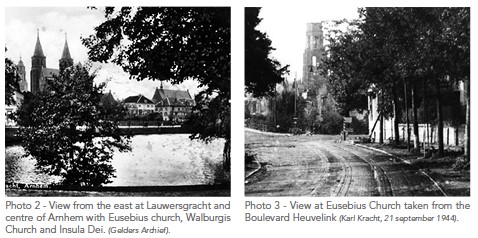
Initially this spot doesn’t seem to match, but if we zoom in, many details seem right: the low wall to the house on the right with the hedge on top. Tram rails an masts for the overhead line, two basement windows at the pavement and the four windows in the façade. Not on this picture but visible on another picture, the house can be seen which has an extension of an orangery at the back. Unfortunately there is no picture found of this house right from behind.
The house was demolished in 1977.
Striking on this picture also is the road sign. When we zoom in on the Tillmann picture, right in front of the house that is left of Insula Dei, a road sign can be seen exactly like that. It doesn’t stand out at first because the picture is overexposed. However there can be no doubt. Even the stripes on the post can be seen. The photographer’s location and both German infantry men must be on the left side just out of sight of Photo 3. The kerb is still visible. Both infantry men are positioned at the front yard of the house at the southern edge of Boulevard Heuvelink. They fire in western direction under the trees crossing the Eusebius Buitensingel and Brouwersgracht. The Walburgis Church is just out of sight and is situated left outside the picture or behind the trees.
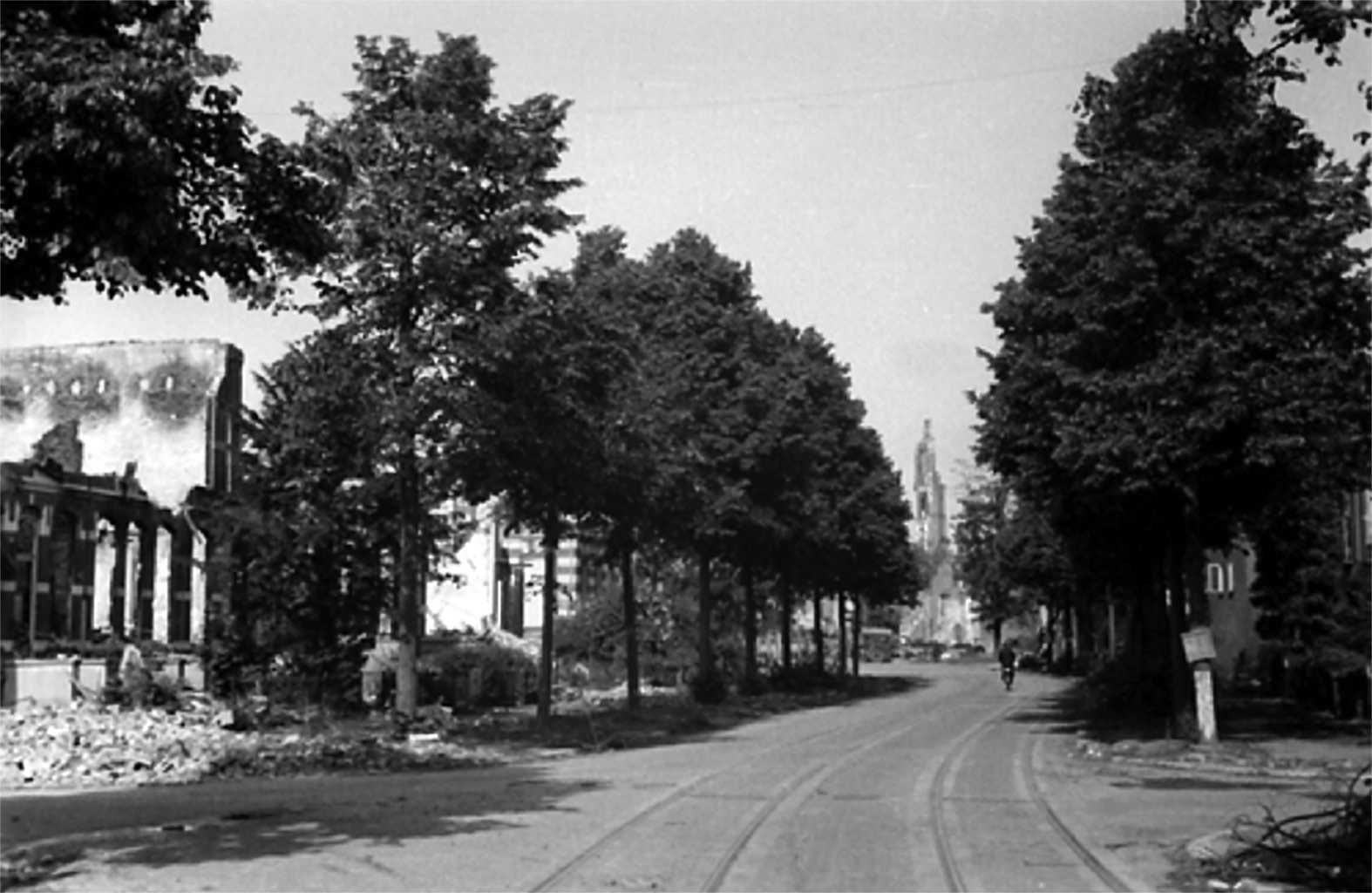
Photo 4 Boulevard Heuvelink 1945 (Gelders archief).
Photo 4 demonstrates the row of houses on that side of the street, just after the war. On this picture trees can be seen on the pavement. And again if we zoom in, a fence is visible that corresponds to the Tillmann picture (Photo 1). Additional indirect evidence exists through another picture taken by Tillmann in the same vicinity. This picture was taken when British soldiers were taken prisoner on the 20th of September at the Van Limburg Stirum School. This makes photo 1 a more than commonly interesting picture since it must have been taken during the first days of the battle. After Monday 18th of September the fighting shifted away from this spot. The corner house later became badly damaged and partly collapsed. It’s visible in Kracht’s picture, but not on the one taken by Tillmann.

GERMANS OUT OF THE WEST
For a long time, the German perspective of the Battle of Arnhem got a lot less attention in literature than the British side. There were Corps and Divisional histories by Tieke en Furbringer, but it took It Never Snows in September appeared until we had a book exclusively focused on the German reaction to Operation Market Garden. More studies have appeared since, but without exception those are focused on the fight around the Bridge at Arnhem and the operations on the eastern side of the Perimeter. This is about to change.
The almost random mix of units fighting the 1st Airborne Division from the west has been called the Divison Von Tettau since the 1950s. Although the units on the eastern side were equally mixed, they were a more or less cohesive whole around the core of the (remains of the) 9th SS Panzer Division. This was hardly the case in the west. The largest unit, and the one with the most combat potential, was the Unterführerschule ‘Arnheim’, under command of SS Standartenführer Michael Lippert. A new book by Bob Gerritsen about this unit, entitled Fighting the British at Arnhem, will be published on on 21 September from R.N.Sigmond Publishing.
The biggest problem, so says Gerritsen when questions, is the condition of our sources. On the Allied side, people started to save reports, personal narratives and analyses almost immediately after the end of the war. Moreoever, the veterans were relatively easy to track down and generally easily encouraged to write down their personal experiences. In so far as any reporting was done on the German side, much did not survive the final months of the war, or ended up scattered over a variety of national archives worldwide, depending on who happened to capture the documents. In some cases, the problems have a legal cause. Some information is availabel in the Dutch archives of the Special Court of Justice in The Hague Michael Lippert himself was charged there but because of privacy concerns of those charged and their relatives, this archive can only be examined under special and limiting conditions.
As far as the veterans are concerned, and insofar as they have survived the war and the often many years as prisoner of war, they were often reluctant to get attention for understandable reasons.
The retired Dutch colonel Th.Boeree succeeded in talking to a variety of German POWs after the war, but only few managed the same since. Many years ago, Bob Gerritsen was able to contact Erwin Heck, the Ordonnanzoffizier of the Unterführerschule. Over a period of years, and often with Heck’s help, Gerritsen was able to collect a vast amount of new information. That has now been recorded in this new book.
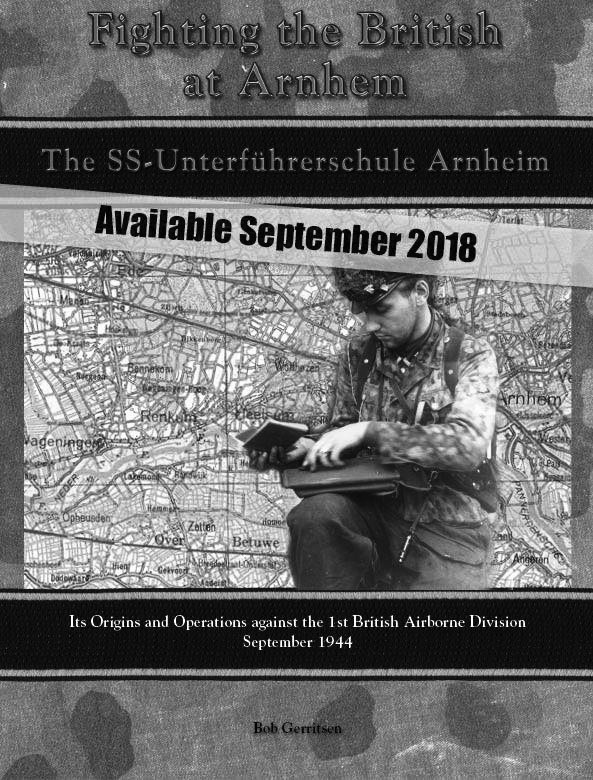
Fighting the British at Arnhem: The SSUnterführershule Arnheim
Written by: Bob Gerritsen Publisher: R.N. Sigmond Publishing 2018 ISBN: 9789081270397
Format: 224p, lavishly illustrated Price: € 34.50 / GBP 30.00
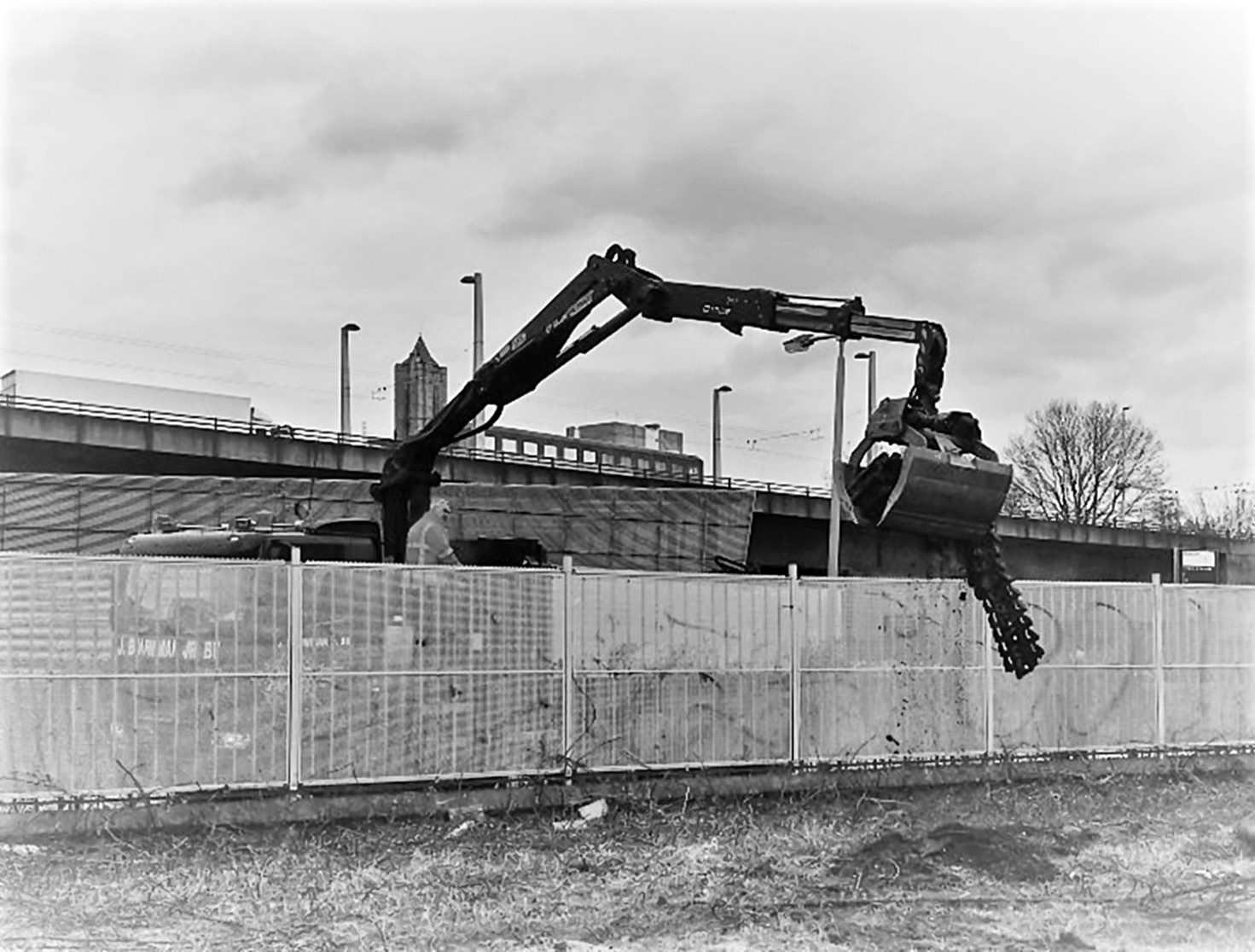
Photo 1: De track wordt met de kraan gegrepen en in de laadbak geplaatst (Photo: M.Clements, C. Beumer).
AN EXCITING DISCOVERY BY ARNHEM BRIDGE
SPECIAL FIND NEXT TO THE BRIDGE
At the beginning of May this year a truck stopped next to the fence of the Cobercoterrein on the Westervoortsedijk in Arnhem. Curious bystanders saw that the crane grabbed a large piece of steel. Was it a piece of the old bridge railing that was removed? Then an elongated piece of rusted iron was picked up that was unmistakably a caterpillar track. The cargo disappeared in the back and the truck left the location. The scene was recorded and the images were shared. But what happened with the cargo that disappeared in that truck? The editors of Airborne Magazine describe in this article what they have been able to discover about that piece of track.
DESTINATION PLAN AND BOMBING
On the eastern side of the bridge lies the site of the old dairy factory. Among older inhabitants of Arnhem, it is better known as the CAMIZ (Coöperatieve Arnhemse Melkinrichting en Zuivelfabriek) or Coberco. In 2015, the development of this area was described in the zoning plan ‘Cobercoterrein’. This is where the Cobercokwartier, a new district where creativity and culture are going to be the main focus. This zoning plan was the reason for the archaeological examination that yielded the special find. On the Coberco area, during the September days in 1944 ferocious fighting took place. The area was fired at by artillery of both parties and hit in the aerial bombardment of the bridge on the 7th of 7 October. The fact that material from that period was found during the examination will not have been a surprise to the researchers. The objects that were taken away with the truck were found in a bomb crater on the site next to the CAMIZ.
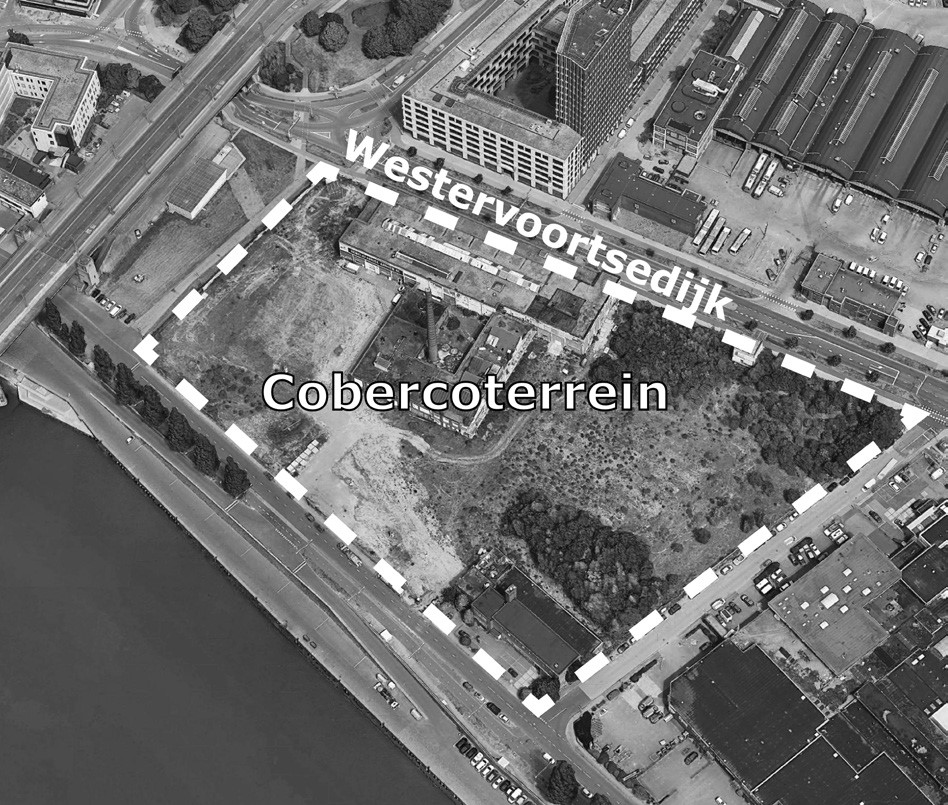
Photo 2: The old CAMIZ factory site (Bron: Google Earth – Image @ 2018 – DigitalGlobe).
IS IT A TRACK FROM THE WAR?
The truck that picked up the objects took them away for further examination. From there, the objects are to be further assessed and the results are recorded in a report for the client.
In anticipation of the publication of this report, a number of facts can be mentioned about the track. The track visually looks like the type for a PanzerKampfwagen IV. Some letter codes are references to a factory in Austria. It concerns ‘cbv’ which was used for products from SchoellerBleckmann AG in Ternitz. On the connecting pins connecting the links ‘kjk’ is visible. This goes to Hengstenberg & Freund from Essen. Finally, in this context it is worth mentioning that close to the spot where the track was found, after the war two tank wrecks were still on site. These were both tanks of the PanzerKampfwagen IV type. What is known about these wrecks?
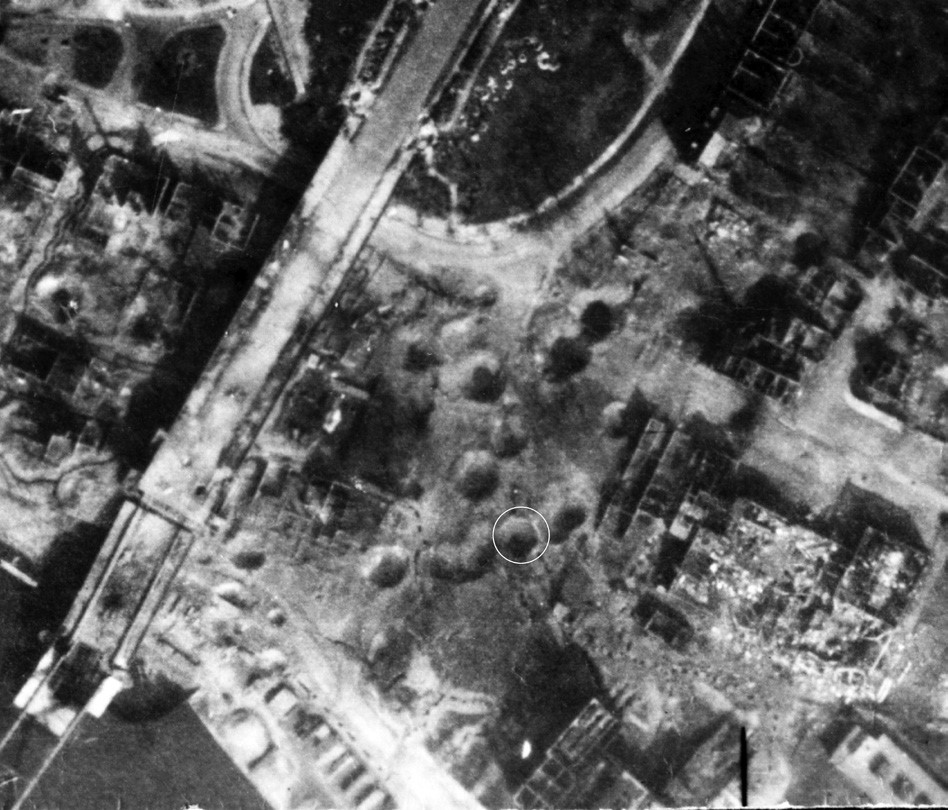
Photo 3: Aerial photograph of 15 March 1945 showing the many craters that are the result of the bombing at the 7th of October 1944. The morning shadow accentuates the PanzerKampfwagen IV in the middle of the Westervoortsedijk, right next to the dairy. The track is found in the circled area just below the middle of the photo (21506 3174/Arnhem 1945, WUR).
TANKS TO THE BRIDGE
In the night of Sunday 17th of September and Monday 18th of September, B Troop of the 1st Airlanding Antitank Battery was able to reach the 2nd Parachute Battalion at the bridge with five antitank guns. These 6pounders were placed in position in the morning twilight.
Two guns covered the eastern access road. Sgt Robson’s antitank gun was positioned west of the bridge and the 6pounder of Sgt Kill stood next to the milk factory on the east side of the road bridge. The Defense Platoon of the Brigade Headquarters and the 8th platoon of CCoy 3rd Battalion had positioned themselves at this location at the eastern side of the bridge and defended the access which came from the Westervoortsedijk.
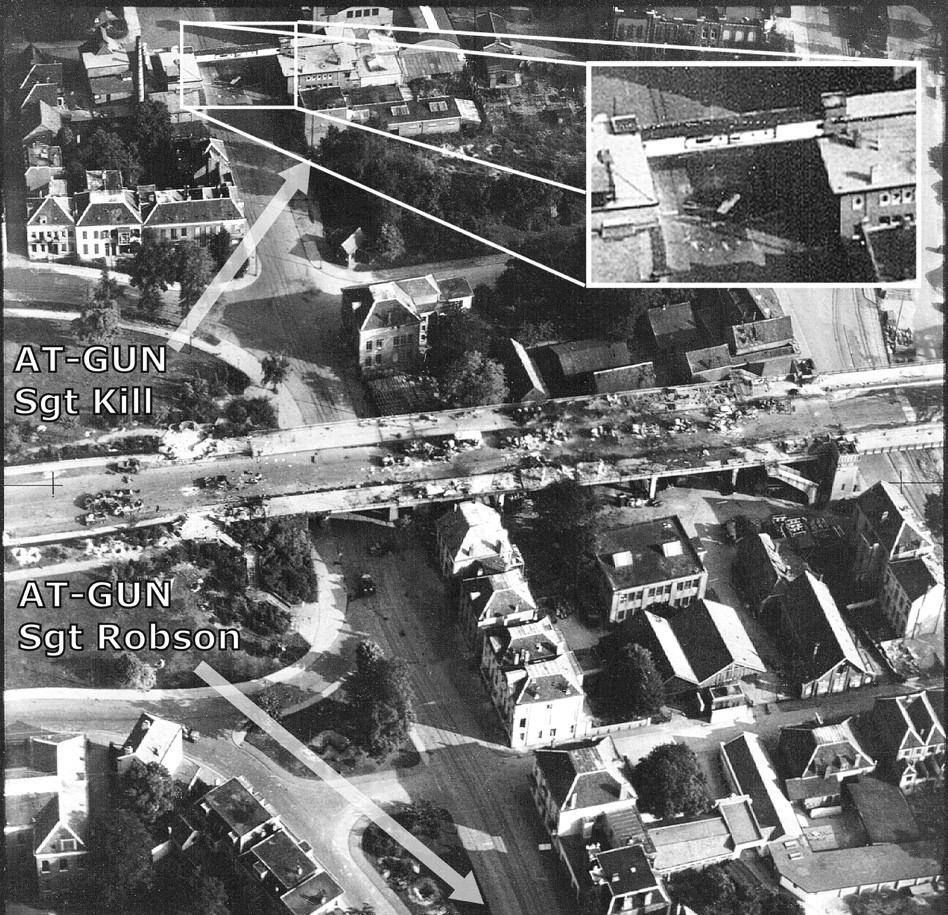
Photo 4: Oblique view from 18 september with the positions of the gun emplacements manned by Sgt Kill and Sgt Robson. The detail shows something is under the bridge. Is that the PzIV? (Bron – B. Gerritsen).
This route to the bridge was used on Monday morning for an attack supported with PanzerKampfwagen III and PanzerKampfwagen IV tanks. Robson’s gun destroyed one of the tanks. The timing of the attack, with regard to the presence of a PanzerKampfwagen III, raises questions. Based on available information we can assume that vehicles of this type were still on the move to Arnhem on Monday morning. The only tanks that could possibly advance towards the bridge on the early morning of the 18th September were the armoured vehicles of the II. Abteilung of the SSPanzerRegiment 10. This unit had about sixteen tanks, including PanzerKampfwagen IVs. This unit is known to have been initially directed to Nijmegen via the Arnhem bridge, but because that road was blocked, the unit was dependent on a ferry connection to the Betuwe. However, on the available aerial pictures of the 18th of September no tank wreck is visible at that location. The aerial photograph of the 19th of September shows a vehicle on the corner of the milk factory and in the shadow under the pipe bridge at the gun of Sgt. Kill the other PanzerKampfwagen IV might be located. Both tanks on the Westervoortsedijk were destroyed between the 18th and 20th of September. In his book German Armored units at Arnhem, Marcel Zwarts makes a distinction between the two wrecks, so it is clear that the tank under the pipe bridge was a modified version used by combat units. The wreck that was left somewhat more to the east was an older type ‘G’ that was used by training units. This brings us to the assumption that the tank closest to the crater, in which the track was found, was used by the SSPanzerRegiment 10.
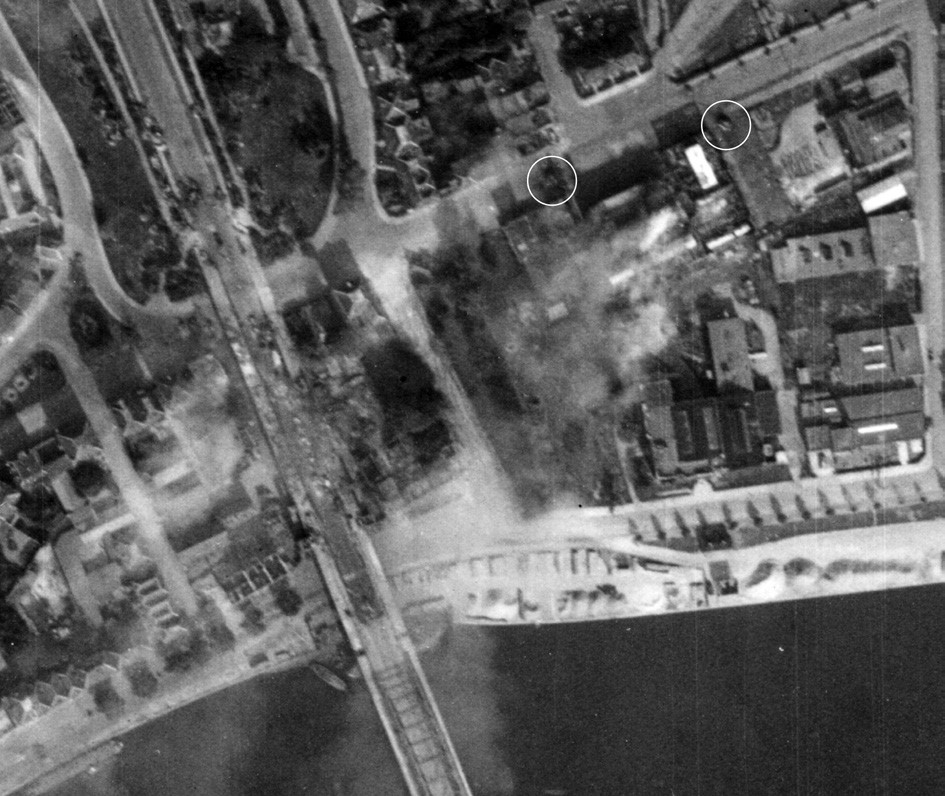
Photo 5: Aerial photograph from the 19th of September 1944. Armoured vehicles are visible on the bridge and plumes of smoke come from the CAMIZ. To the right of the factory is a vehicle which could be the tank belonging to the training unit. Whether this vehicle is already disabled is not clear. Under the pipe bridge of the dairy, a large shade partially obscures a rectangular vehicle. Could this be the second PanzerKampfwagen V? (Bron: 240083030, Arnhem 1944 WUR)
BAILEY BRIDGE
After the liberation in 1945, the crater landscape next to the bridge was soon leveled to build a bailey bridge. The easiest solution would have been to fill up the craters by bulldozing the debris of the devastated environment. It might be possible that the track has been pushed into a crater in this way, where it remained buried for 73 years.
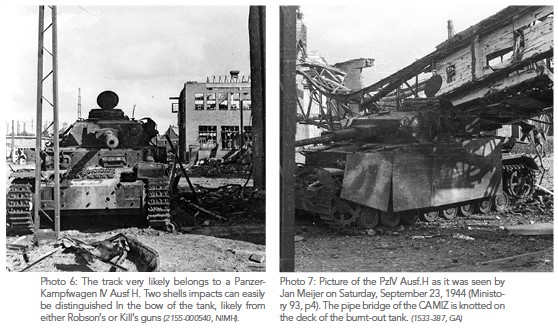
CONCLUSION
Investigating the collected data it seems very likely that the found track belongs to the PanzerKampfwagen IV Ausführung H which was destroyed on the 18th or 19th of September on the Westervoortsedijk. The destruction of this tank can be attributed with great certainty to one or both guns from B Troop led by Sgt. Kill and Sgt. Robson. The report on the Cobercoterrein will perhaps reveal new facts about the track. It may bring new facts on the story of this spectacular find. With the completion of that research the question arises what the destiny of the track will be. It would be a right if the object was given a proper place in a publicly accessible place in the new Cobercokwartier, near the place where it was found as a reminder of this special chapter in the history of Arnhem. (With thanks to: C. Beumer, M. Clement, B. Gerritsen, W. Schwabe and H. Timmerman) Leo van Midden
VERDER LEZEN
• Gerritsen, B., & Revell, S. (2010). “Retake Arnhem Bridge”: an illustrated history of Kampfgruppe Knaust: SeptemberOctober 1944. Renkum: R.N. Sigmund Publishing. • Steer, F. (2003). Arnhem: the bridge. Barnsley: Leo Cooper. • Wilkinson, P. W., & Dauncey, B. M. D. K. (1999). The Gunners at Arnhem. East Haddon: P W Wilkinson. • Zwarts, M. (2003). German armored units at Arnhem, September 1944. Hong Kong: Concord Publications.
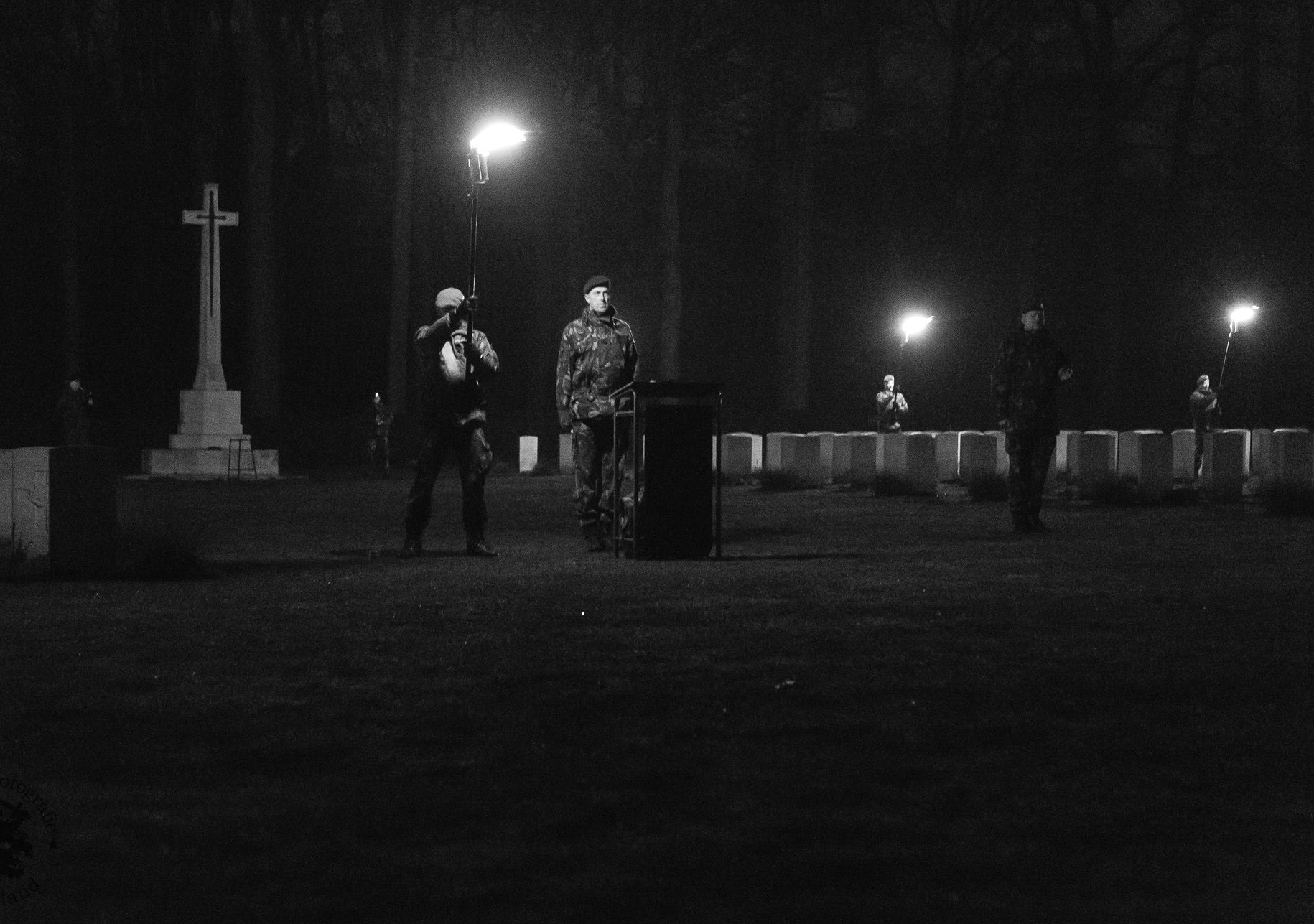
(Foto: Dutch Defense Press)
SOLDIERS OF THE AIR MOBILE BRIGADE VISIT THE AIRBORNE CEMETERY
Visiting the fields of honour at the Airborne Cemetery in Oosterbeek, is a fixed ritual at the end of the basic training of new Airborne soldiers of 11 Air Assault Brigade. Just a few hours of darkness before the physical and demanding Airmobile selection course ends by marching into the barracks at Schaarsbergen, they gather at the cemetery. During this ritual they commemorate their predecessors and are called upon symbolically to take over the torch. An act of commitment to live and act the same culture and dedication of their Airborne predecessors and an obligation to themselves and their comrades.
At Thursday night 2400 hours on the 30th of May, 52 soldiers of the Airmobile Basic Training
visited Oosterbeek Cemetery. Below Chaplain Joosen’s speech, the chaplain attached to the Airmobile Basic Training Centre, is addressed. ‘Just a few hours left before you will be badged by the maroon beret. But first, we are here, on the Airborne Cemetery. This field of honour is a place where the past rests and even we are given some moments to unwind. A quiet moment in which the past, present and future merge together. We commemorate and try to find the proper words and tell each other known and unknown stories from the past. It adds colour to the Air Assault Brigade. It gives soul to our existence and character to our regiments’.
‘These 1700 tombstones are the witness of a fierce battle which raged in this area. After the Normandy landings the Allied advance was halted due to the lack of supplies and a fiercer resistance of the Germans. That situation resulted into the making of plan Market Garden.
A bold and ambitious plan to cross three rivers and form a foothold north of the river Rhine and to press on to encircle the German industrial centre. On Sunday the 17th of September 1944, 10.000 British and American paratroopers landed by parachute on various places in our country. In the end the bridge at Arnhem turned out to be a bridge too far. So many paratroopers, who left home and hearth, never to come home again’. ‘That was also lieutenant John Hollington Grayburn’s fate. He landed at Heelsum on the first day of the operation and succeeded in reaching the roadbridge at Arnhem. There, with his comrades of 2 Parachute Battalion and others, he was supposed to hold on until to be relieved by the advancing ground forces of XXX Corps. That night lieutenant Grayburn tried to press on to the southern edge of the bridge. He was fired upon by a German machinegun and got hit in his shoulder. He continued to press forward with the greatest dash and bravery until casualties became so heavy that he was forced to withdraw. Later his platoon was ordered to organize the occupation of a house that was vital for the defence of the bridge. Despite ceaseless attacks by enemy infantry, mortars, tanks and selfpropelled guns it did not fall to the enemy. He exposed himself constantly while moving among and encouraging his platoon. When the house was finally set on fire on the 19th of September it had to be evacuated. Again he took command of the elements of all arms and succeeded in organizing a defensive position to cover the approaches to the bridge. As the enemy succeeded in laying demolition charges under the bridge on the 20th he organised a fighting patrol which drove the enemy off temporarily. He was again wounded but refused to evacuate.
When he personally directed the withdrawal of his men to a new position, he was killed’. John Grayburn became 26 years old. For supreme gallantry and determination he was awarded the highest Britsh military award for bravery, the Victoria Cross. For that reason we have positioned a torch at his grave tonight’.

(Foto: Dutch Defense Press)
‘A commemoration like this is entering the land of silence. We are on holy ground. The commem
oration of those who died during Market Garden has a clear purpose. It’s an opportunity to connect you with them through the colour of the beret. Of course, the Second Wold War is over, but for many on earth, every day is still black and without hope. The battle for justice is never over.
Within 11 Air Assault Brigade we understand that this might bring risks to us. That’s why we commemorate, brother in arms wearing the red beret, who died during missions in the service of our Brigade. We call with reverence: Raviv van Rensen, Jeffrey Broere, Dave Steensma, Bart van Boxtel, Cor Strik, Jos Leunissen, Tim Hoogland, Mark Weijdt, Henry Hoving, Kevin Roggeveld,
‘We honour them with our respect’
‘Later on, when you will put on your red beret you will connect their story with the future. You will take over the torch which brings responsibility. It’s up to you to meet the expectations. That’s not just
an obligation for yourselves and your comrades, but to all the others who have preceded you’. ‘To support you I will end with the holy words originated from a fierce battle that raged here.
Within the centre of the Perimeter in Oosterbeek, where British and Polish soldiers defended until the 25th of September, a 1000year Old Church is located. On the wall of the church the so called Airborne Prayer is attached in two languages. A prayer for all soldiers, anywhere in the world, indifferent in what kind of conflict or war’.
May the defence of the Most High be above and beneath around and within us, in our going out and in or coming in, in our rising up and our going down, all our days and all our nights, until the dawn when the son of the righteousness shall arise, with healing in his wings for the peoples of the World, through Jesus Christ our Lord.
Amen.
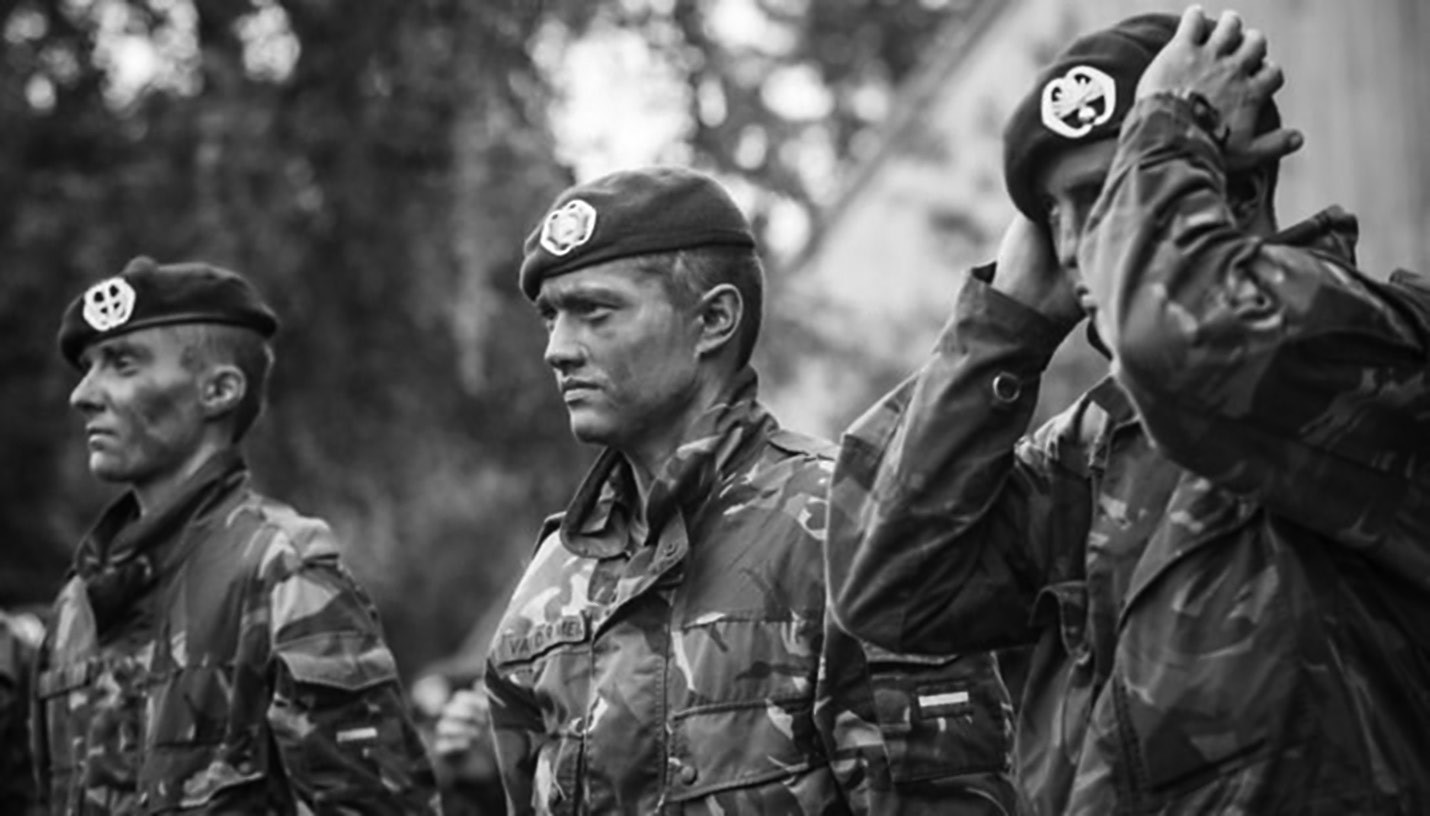
(Foto: Dutch Defense Press)
2018 PROGRAM
8 SEPTEMBER:
Battlefield tour Arnhem “The nine day battle at Ede, Arnhem and Oosterbeek, September 1944.“
Starting location: Talsmalaan, Oosterbeek.
Next to the Airborne Museum.
Time: 09.00 – 17.00.
Cost: SFAM members € 40.00, nonmembers € 45.00.
The tour included bus transport and lunch. All participants receive a guide for this tour.
6 OCTOBER:
Battlefield tour: “The contributions of 1st Batallion The Border Regiment.“
Location: Talsmalaan, next to Airborne Museum Hartenstein.
Time: 09.00 – 17.00.
Cost: SFAM members € 40.00; nonmembers € 45.00.
Erik Jellema will lead this tour. The tour includes bus transport for the morning section and lunch. The afternoon section is a walking tour.
19 OCTOBER:
Theme night: “The Polish Brigade“
Location: ’t Huukske, Mauritsstraat 22, Arnhem Time: 19.30 – 22.00.
Cost: Free Themed evening with introductions by a variety of experts about the operations of the Polish Independent Brigade, followed by general debate.
10 NOVEMBER:
Airborne Day
Location: Concertzaal, Rozensteeg 3, Oosterbeek.
Time: 10.00 – 15.00.
Cost: € 2.50.
Presentation and discussion of Airborne materials and documents belonging to members. Trading is possible, along with a book sale and other activities.
A simple lunch will also be available. For more info please contact Wim Boersma (w.boersma@wxs.nl)
PROPOSED 2019 PROGRAM
SPRING
March: General members meeting with a lecture by Landstorm March / April: Bookfair tbd: 156th Battalion Battlefield Tour tbd: Theme night 12 to 16 May: Trip to Normandy
FALL
September: 75th anniversary Battle of Arnhem Battlefield tour September/ October: Lombok Battlefield tour October: Pegasus 2 Battlefield tour October: Theme night November: Airborne day For further information concerning the various activities, to sign up for events, or to make changes to reservations, please visit www.vriendenairbornemuseum.nl or send an email to: activiteiten@vriendenairbornemuseum.nl
UPCOMING ISSUES OF AIRBORNE MAGAZINE
NUMBER 13 DECEMBER 2018
NUMBER 14 FEBRUARY 2019
NUMBER 15 JULY 2019
NUMBER 16 NOVEMBER 2019
CONTRIBUTE TO THE MAGAZINE
The editors are eager to hear your comments and suggestions, and welcome any articles you may want to send in. For an efficient process, please request the submission guidelines via the email address magazine@vriendenairbornemuseum.nl.
The Airborne Magazine is a publication by the Society Friends of the Airborne Museum, Oosterbeek and is released three times a year. The purpose of the magazine is to promote the Airborne Museum, the activities of the Society of Friends, and the general history surrounding the Battle of Arnhem.
Editorial staff: Alexander Heusschen Jasper Oorthuys Otto van Wiggen
Archive and distribution of magazine back issues: info@vriendenairbornemuseum.nl
Design and layout: Christy Beall
Printing: Grafi Advies, Zwolle
SFAM Email address: info@vriendenairbornemuseum.nl SFAM telephone number: +31 06 510 824 03.
Mailing address: VVAM, Wissenkerkepad 22, 6845 BW, Arnhem.
Website: www.vriendenairbornemuseum.nl
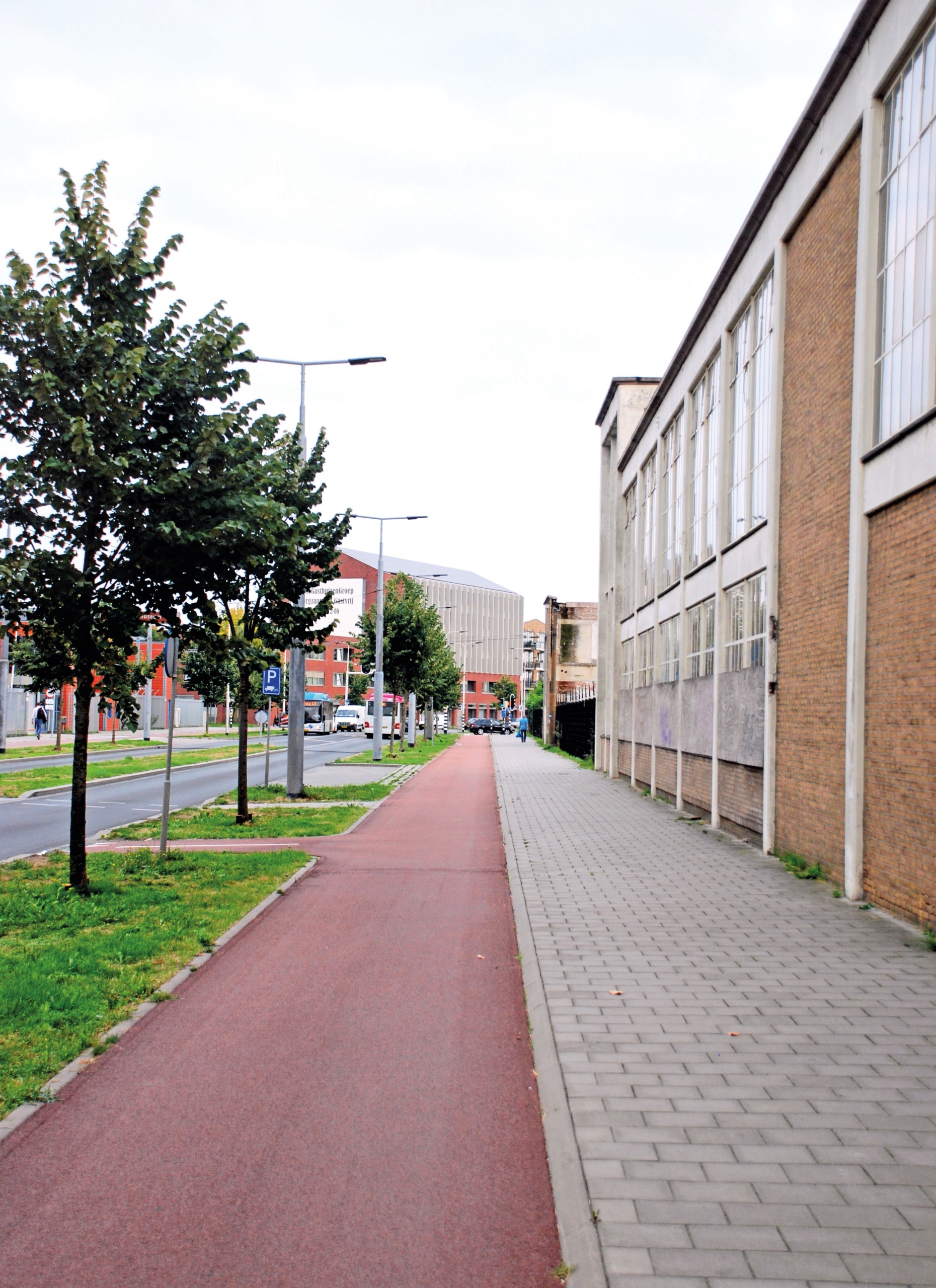
The Westervoortsedijk in Arnhem nowadays, at the approximate location where the Panzer IV tank shown on the cover was stopped by shots fired by the 6pounder antitank guns of sergeant Robson and/or sergeant Kill located in Frost’s positions. (Photo Alexander Heusschen)

Plaats een Reactie
Vraag of reactie?Laat hier uw reactie achter.